Table of Contents
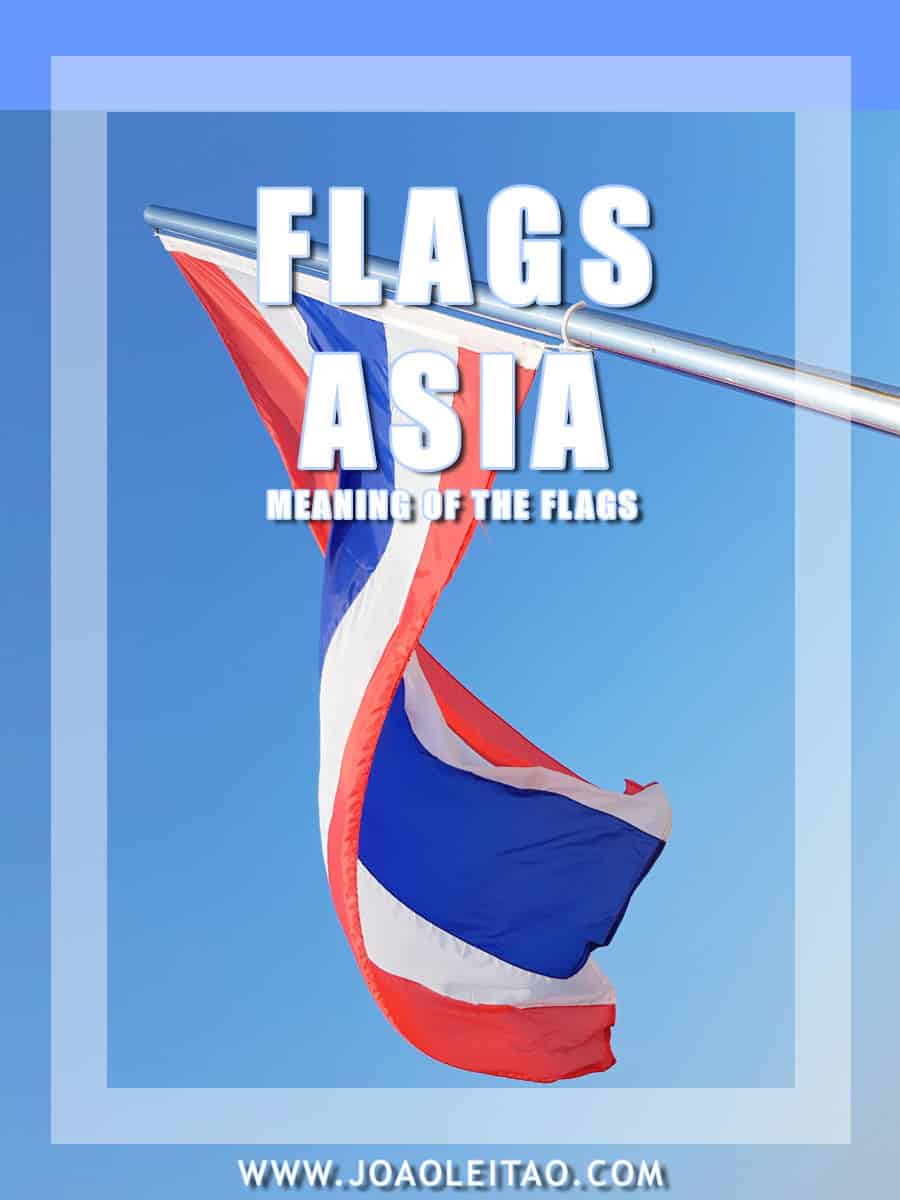
The flags represent the national identity of each country. Each color has a meaning in the history of nations. Asian flags vary on color and meaning. On this page, I list all flags of Asia and their colors.
Copyright: I own the copyright usage of these images. You cannot use text or image without permission.
Asia National Flags
Alphabetic order
Flags of Asia
Flag of Afghanistan
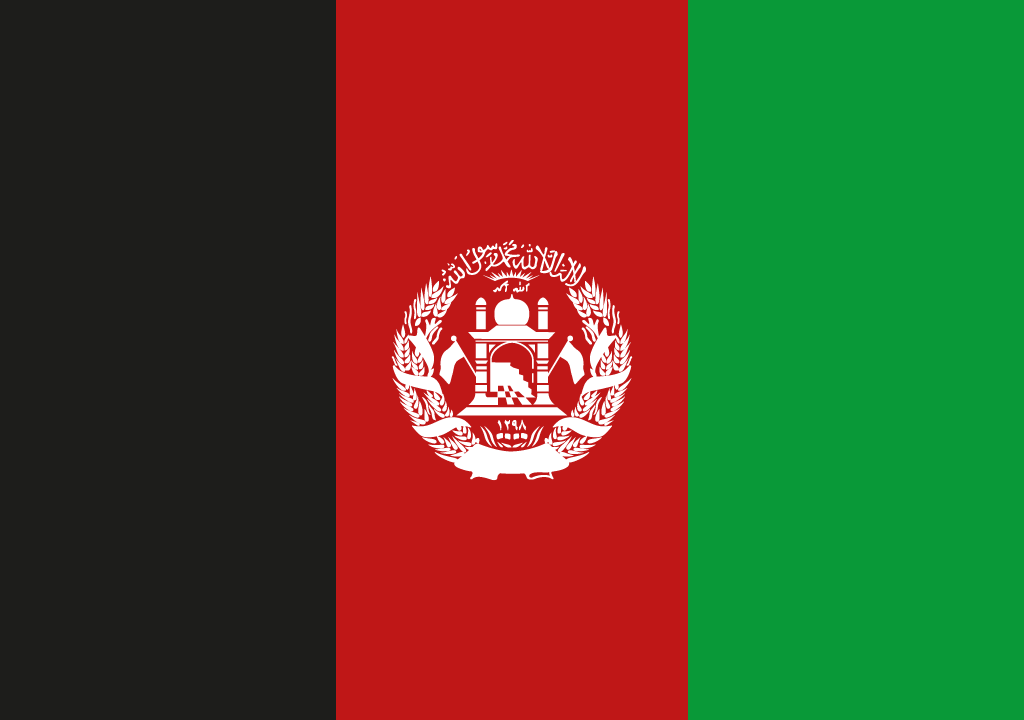
3 colors: black, red, green.
Meaning of the flag of Afghanistan: The colors of the flag of Afghanistan include the pan-Arab colors of black, green, red (and white), which represent the historical dynasties that once ruled the region. Although not everybody agrees, it is thought that black represents previous Afghan flags which symbolized the sovereign; red is as a sign of progress, copied from the Soviet flag; green represents Islam. The white coat of arms in the center is a mosque with its mihrab facing toward Mecca. The mosque is surrounded by two sheaves of wheat. Above the coat of arms, the sacred line is written, “There is no God but Allah and Mohammad is His prophet, and Allah is great.” Below the insignia is written “Afghanistan 1298”.
History of the Flag of Afghanistan
The flag of Afghanistan has three vertical stripes: black, red, and green from left to right. In the center, the national symbol overlaps the red stripe. It’s a complex composition that includes a mihrab (a Mosque niche that marks the direction of Mecca) and a minbar (a pulpit). In Arab, the inscription “God is Great.”
The black represents the old Abbasid Caliphate, the red symbolizes the dignity of the royal family, and the green is the traditional color of Islam. It’s a flag inspired by the old imperial flag, with a religious meaning that’s reinforced by the emblem in the center.
The current flag was officially adopted in 2013 but has the same basic design of several flags used over the years, with several changes.
A black flag used since the middle of the 18th century, to which different elements were added, had the same symbol we see in the flag today in 1928. That was the year King Amanullah visited Europe, and that may have influenced his decision to change the flag and adopt the three-colored design that lasted until the present time. Between 1928 and now, there were only three times when the Afghan flag didn’t have this three-colored design. The longest period when it happened was during the Taliban regime that ended in 2002.
Flag of Armenia
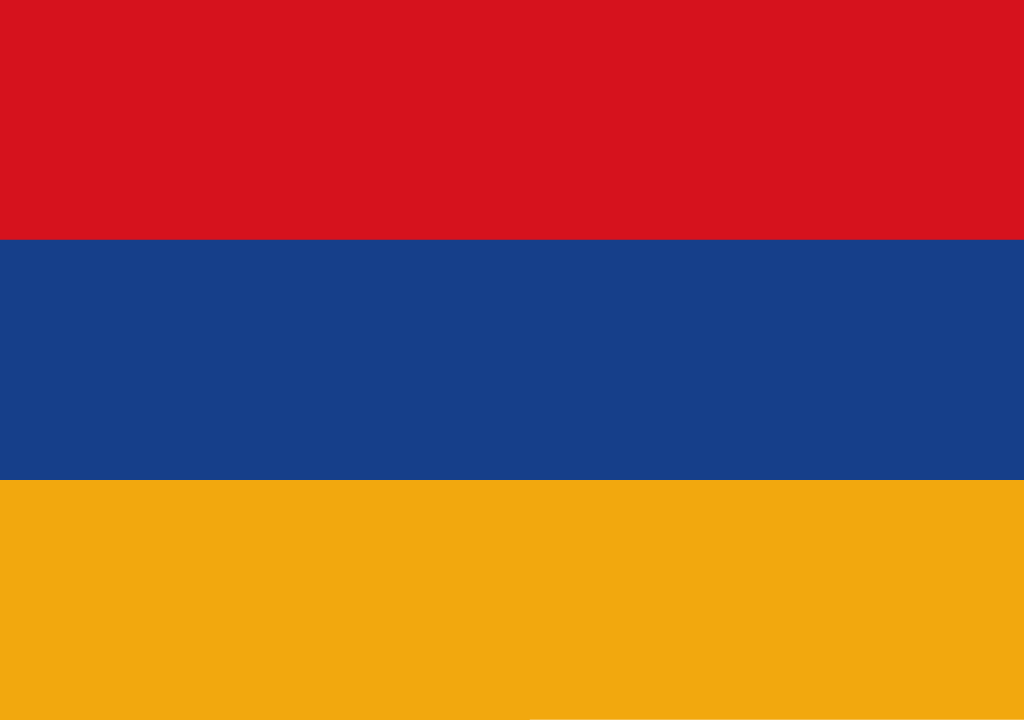
3 colors: red, blue, orange.
Meaning of the flag of Armenia: The colors on the Armenia Flag represent its people. Red stands for the sacrifice and blood of the Armenian soldiers shed in past and present wars; orange symbolizes the fertile lands of the country; blue represents hope and aspiration for the progress of Armenia.
History of the Flag of Armenia
The flag of Armenia has three horizontal stripes: red at the top, blue in the middle, and mustard yellow at the bottom.
This flag appeared during the First Republic of Armenia (1918-1922), between the end of the Transcaucasian Democratic Federative Republic, a political union that included Georgia and Azerbaijan, and the time when they became part of the Soviet Union.
The symbolism of the colors is officially defined in the Constitution. The red represents the mountains of the country, the Armenians, their permanent fight for survival to maintain Christian faith, and the country’s independence and freedom. The blue symbolizes the Armenians wish to live under a blue sky, which means peace and stability. The yellow symbolizes the Armenians’ creativity, talent, and ability to work hard.
Other interpretations connect the red to the Armenian Genocide, the blue to the sky, and the yellow to the courage of the Armenian people.
The current flag was officially adopted on 24 August 1990, after the collapse of the Soviet Union and Armenia’s independence. The flag is similar to the one used during the First Republic of Armenia but with different proportions.
Flag of Azerbaijan
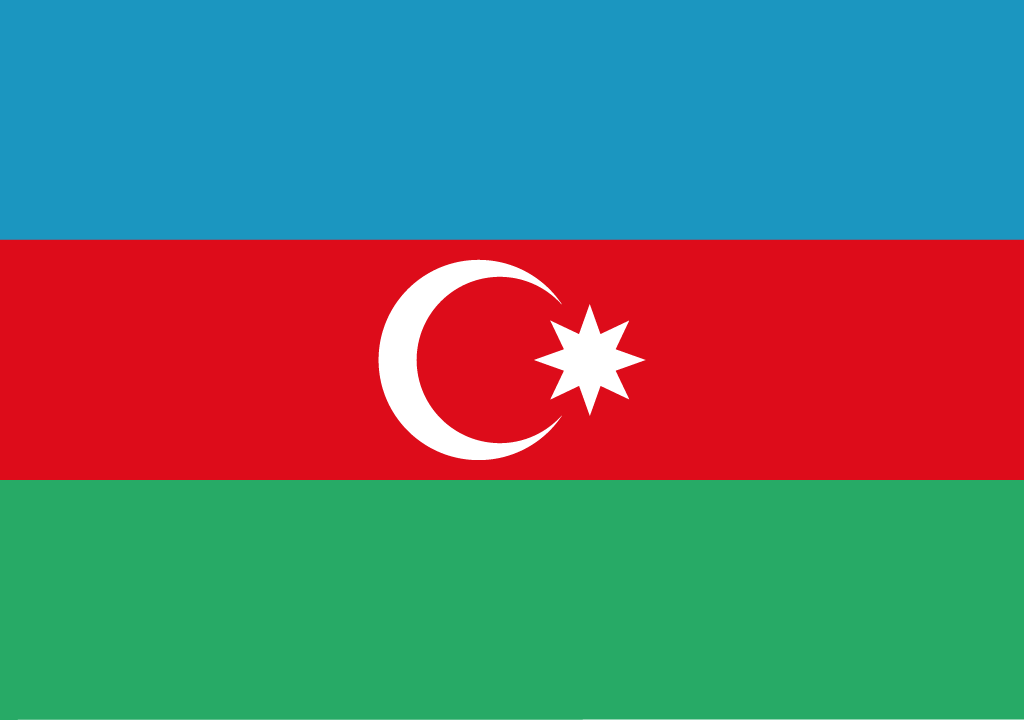
3 colors: blue, red, green.
Meaning of the flag of Azerbaijan: Blue symbolizes the Turks; red represents progress; green is for Islam. The white semi-circular moon, or crescent, is also for Islam; the eight points of the star stands for the eight branches of the Turkic people.
History of the Flag of Azerbaijan
The flag of Azerbaijan has three horizontal stripes: light blue at the top, red in the middle, and green at the bottom. There are a white Crescent Moon and an eight-point star in the middle, overlapping the red stripe.
The blue symbolizes the country’s Turkish cultural heritage, red symbolizes progress, and green is the traditional color of Islam.
As for the Crescent Moon and the star, it could be easily associated with Islam, but the star raises some questions. Some authors believe it’s a coincidence that the number of points in the star is the same as the number of letters in Azerbaijan (in Arab), and the same as the number of Turkish tribes who live in the country.
As it happened with Armenia, the current flag of Azerbaijan was used for the first time between 1918 and 1920, after the end of First World War and before joining the Soviet Union.
The flag was created by the first and only president of Armenia during that period, Mammed Amin Rasulzade, and the original flag made by him and his wife is displayed at the Museum of History of Azerbaijan. According to Mammed Amin Rasulzade, the flag represented a connection to the Turkish heritage, modernity, and the Islamic culture.
Uzeyir Hajibeyov, the composer of the national anthem, included references to the flag, linking the blue to multinationalism, red to progress and culture, and green to Islam.
For historian Nasib Nasibli, it was Ali bey Huseynzade, one of the ideological mentors of the Azeri nationalist movement, who designed the color combination in the flag.
Smaller changes were made to the flag when it was officially adopted on 5 February 1991, after the Soviet Union collapse and the country’s independence.
Flag of Bahrain
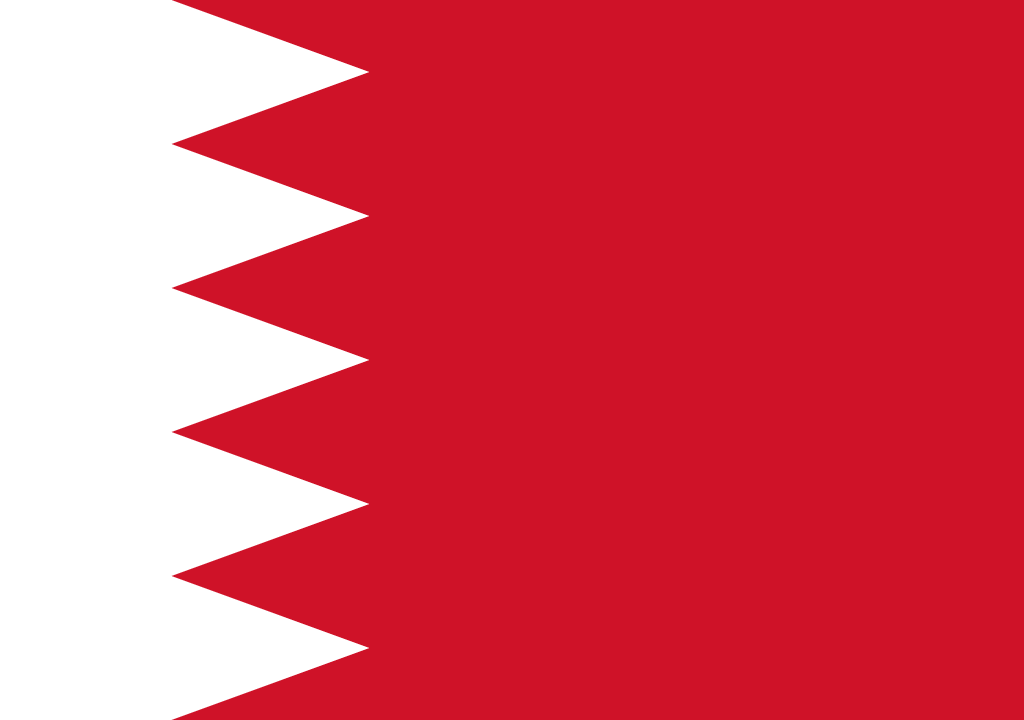
2 colors: white, red.
Meaning of the flag of Bahrain: Red represents the Kharijite sect of Islam; white indicates the truces Bahrain had made with neighbouring countries in the 19th century. The serrated triangles exist to distinguish the Bahranian flag from the ones of its neighboring countries and represent the five pillars of Islam.
History of the Flag of Bahrain
This flag has two colorful areas: white on the left and red on the right. A zig-zag line separates the two areas, a different effect in world flags. Only Qatar, another country in the Persian Gulf area, has a similar flag.
That visual composition creates five triangles. There used to be more triangles, but the final number was decided in 2002, to symbolize the five pillars of Islam.
The first concept for the current flag appeared in 1932. Before that, the first flags of Bahrain, that appeared at the end of the 18th century, had been entirely red, with a white narrow vertical stripe on the left side introduced in 1820. That change was forced by the naval pact with the United Kingdom, which established that the flags on the ships of all countries involved would have a white stripe.
The current flag was officially adopted on 14 February 2002.
Flag of Bangladesh
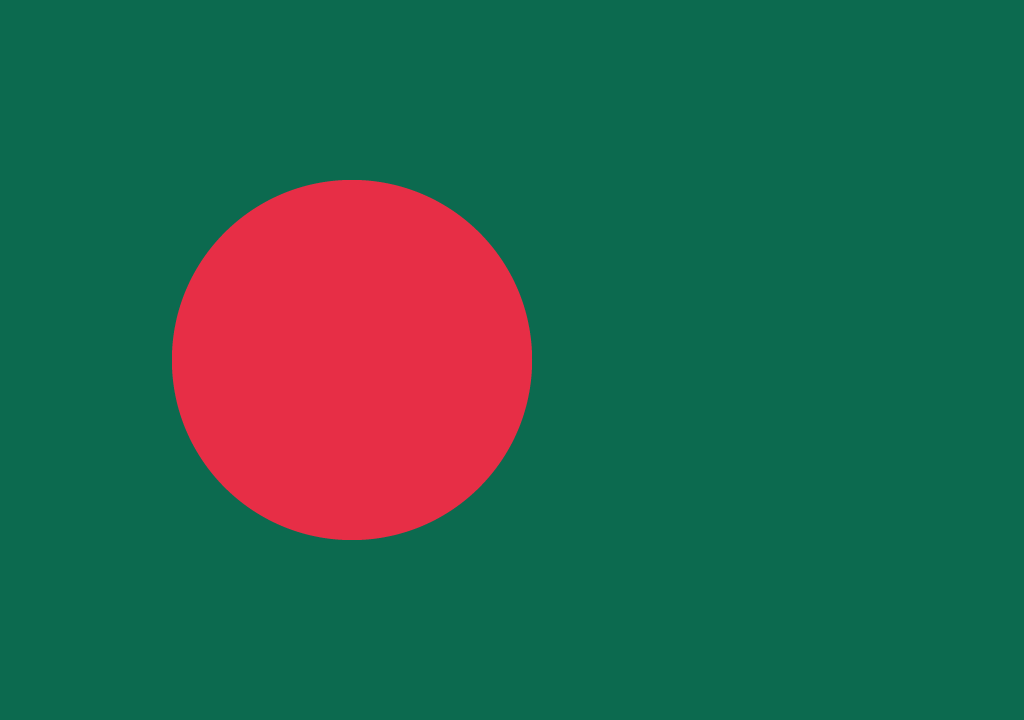
2 colors: green, red.
Meaning of the flag of Bangladesh: Green stand for the greenery of Bangladesh, its vivacity and youthfulness, as well as it is the traditional color of Islam; the red disc stands for the rising sun and the blood spilt by the the people in Bangladesh to achieve their independence.
History of the Flag of Bangladesh
The flag of Bangladesh is entirely green with a red circle in the center. Actually, the circle is slightly off to the left, so it appears to be in the center when the flag flaps in the wind.
The symbolism is straightforward. The red circle represents the sun rising over the region of Bengal, that includes a part of India and Bangladesh, but also the blood shed during the fight for the country’s independence. The green background symbolizes the landscapes of Bangladesh, but it’s also connected to Islam.
The flag has a curious history. It was designed by a group of students and activists that belonged to the Swadheen Bangla Nucleus, on 6 June 1970. They gathered in a room of a university residency in Dhaka, and made the flag with the clothes donated by Bazlur Rahman Lasker, who was the owner of Apollo Tailors in the new market in the city.
That first flag, used during the Bangladesh Liberation War, used to have the outline of the country inside the circle, and it was hoisted for the first time at Dhaka University on 2 March 1971.
After Bangladesh became independent, the current version of the flag was officially adopted on 17 January 1972.
Flag of Bhutan
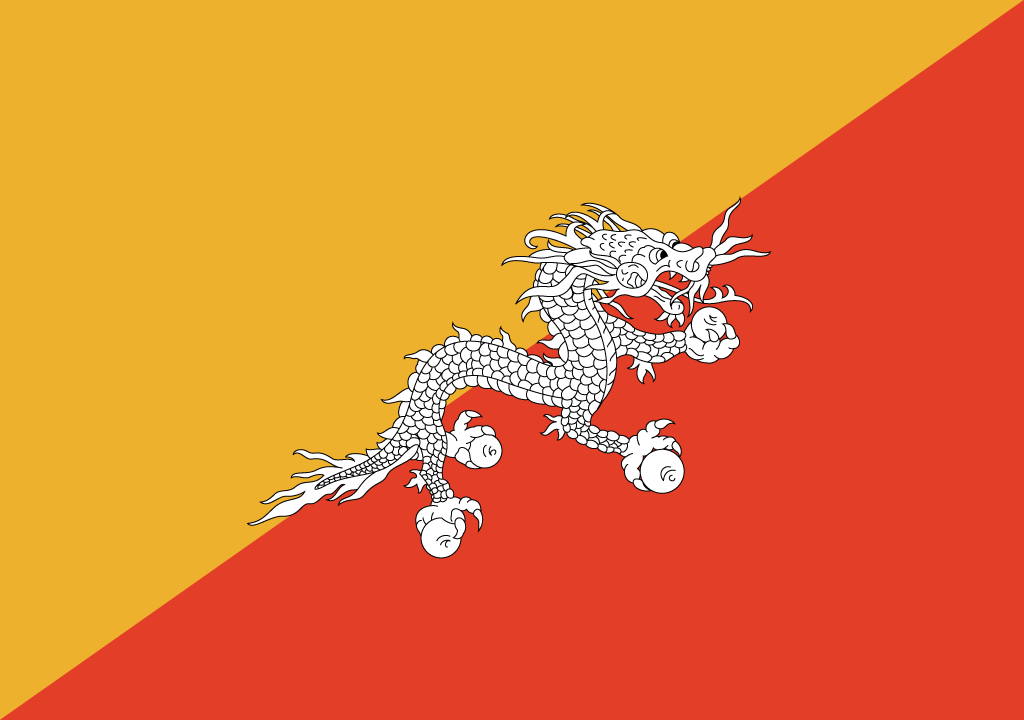
3 colors: red, yellow, white.
Meaning of the flag of Bhutan: Yellow represents the secular authority of the King; white stands for purity and loyalty; red represents the Drukpas monasteries and Buddhist religion. The dragon is holding jewels in its claws, which signify the nation’s wealth; the snarling mouth of the dragon symbolizes the strength of the people protecting the country.
History of the Flag of Bhutan
The flag of Bhutan has two triangular areas: the top left is yellow, and the bottom right is orange. In the center, covering most of the flag, there is a white dragon with black lines.
The dragon symbolizes the name of the country, Druk Yul, which means something like “the country of the dragon that spits fire.” That name is associated with the Druk monastery, founded in the 13th century.
The yellow symbolizes secular life, and the orange symbolizes the importance of Buddhism in Bhutan. Both colors together in equal proportions symbolize the sacred bond between royalty and the people of Bhutan. The white represents purity. Those flag symbols are officially defined in the Constitution.
Although a flag inspired by the same symbols existed since the 19th century, the modern version was designed in 1947 by Mayeum Choying Wangmo Dorji, the mother of queen Kesang Choden.
The flag had a series of changes made in the late 1950s by Jigme Dorji Wangchuck on king’s request. Officially, the current flag was adopted in 1969, although the differences are practically indistinguishable.
Flag of Brunei
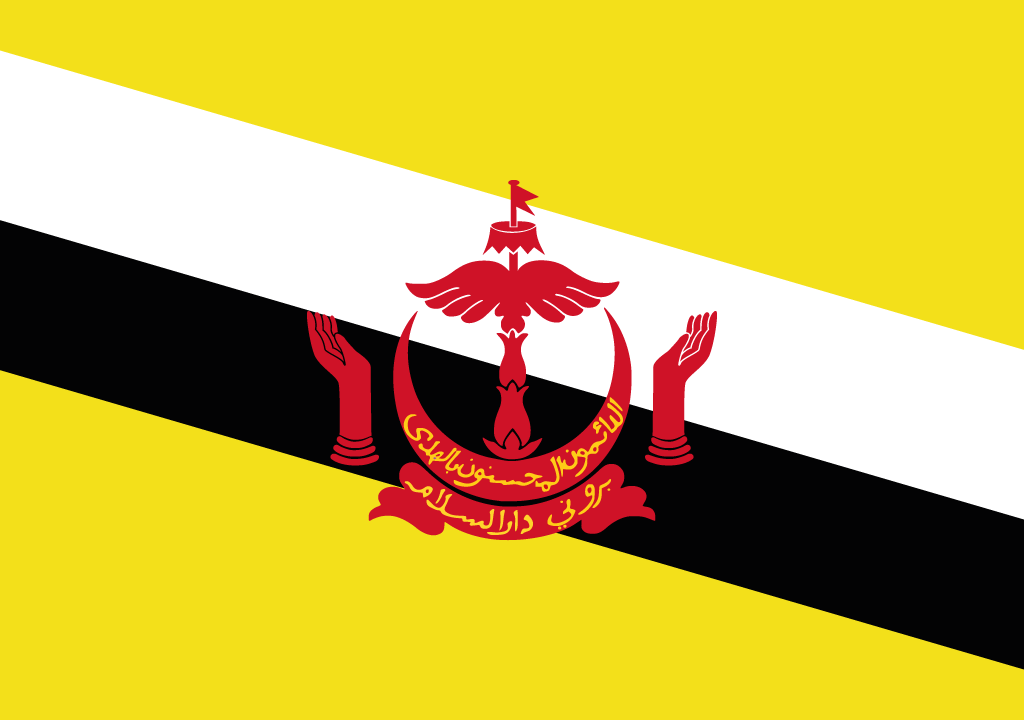
3 colors: yellow, black, white.
Meaning of the flag of Brunei: Yellow is the color of royalty and represents the sultanate; white and black bands symbolize Brunei’s chief ministers. The coat of arms is a crescent (symbol of Islam) connected with a parasol (symbol of monarchy), with two gloves on both sides. The inscriptions in the crescent and the ribbon have Arabic inscriptions which translate to “State of Brunei, Abode of peace” and “There is no deity but God, Muhammad is the messenger of God”.
History of the Flag of Brunei
The background of the flag of Brunei is yellow, which has been the color of the Sultan of Brunei since the Middle Ages (elsewhere in Southeast Asia, yellow is typically associated with royalty), with two diagonal stripes from the top left to the bottom right, one top white and one bottom black.
In the center, the national symbol in red with the inscription in yellow “Always render service with God’s guidance.” The symbol includes a Crescent Moon laid out horizontally, with the tips pointing up towards the sky, protected by an umbrella. On both sides, there are two hands with palms facing up. The umbrella symbolizes Monarchy, and the hands symbolize Government’s benevolence.
The white and black stripes symbolize the two ministers of the Sultan. Earlier, these two state figures used to be the mentors of the young kings and later their advisors. The black stripe that represents the Prime Minister is slightly wider.
This flag has a long History, and it evolved over the years with new elements being added. The completely yellow flag of the Empire of Brunei appeared in the mid-14th century. When it later became a British Protectorate, between 1906 and 1959, they used the same flag but without the emblem in the center.
Brunei adopted the current flag in 1959, after independence.
Flag of Cambodia
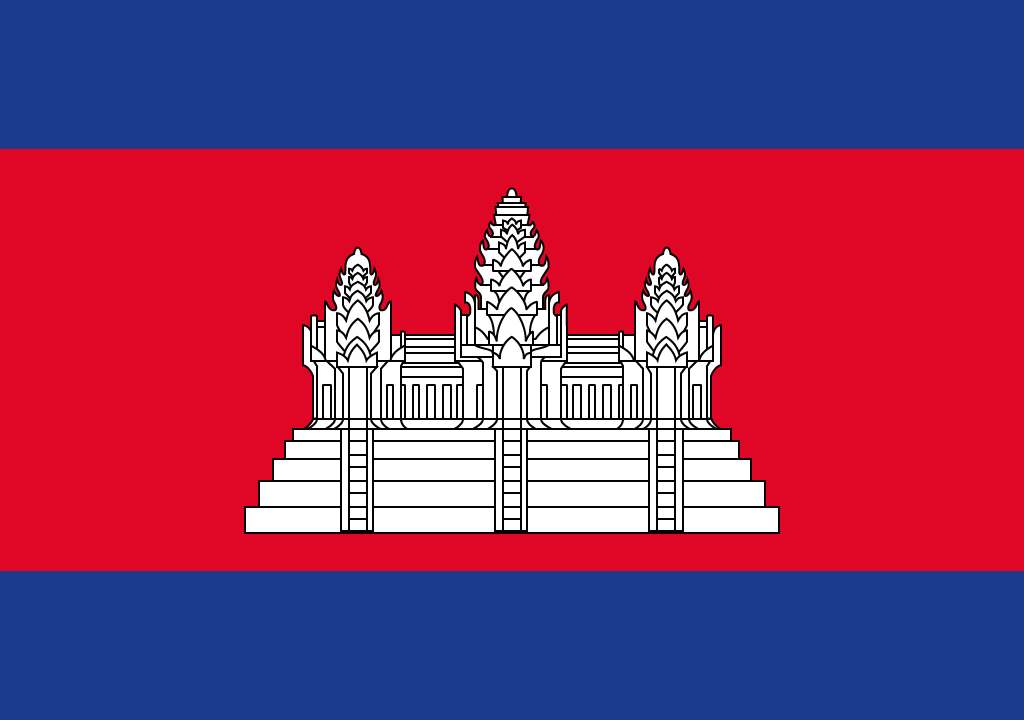
2 colors: blue, red.
Meaning of the flag of Cambodia: Blue represents the nation’s royalty; red stands for the nation; white symbolizes religion. The emblem of the Angkor Vat Hindu temple represents the structure of the universe.
History of the Flag of Cambodia
The flag of Cambodia has three horizontal flags: one wider red in the middle and two dark blue (top and bottom). In the center of the flag, overlapping the red stripe, there’s a depiction of the famous Angkor Wat, the main temple of the amazing city that once existed near what’s now known as Siem Reap.
The red stripe symbolizes the bravery of the Khmer people and is associated with the nation as a whole. The blue symbolizes freedom, cooperation, and fraternity, and is also associated with the flag of the royal house. The temple symbolizes justice, cultural heritage, and integrity, but it’s also connected to the importance of religion.
The flag was initially adopted in 1948, after the independence of Cambodia from France, but the Cambodian flag had the same colors and an image of the temple in the center since 1863. When the Khmer Rouge (Red Khmer) rose to power, a violent regime that controlled the country from 1976 to 1979, the flag was changed into an entirely red flag with the symbol of the temple in yellow. Under the Vietnamese ruling that followed, the flag was practically unchanged and after two more versions, the old national flag returned, officially adopted in 1993.
Flag of China
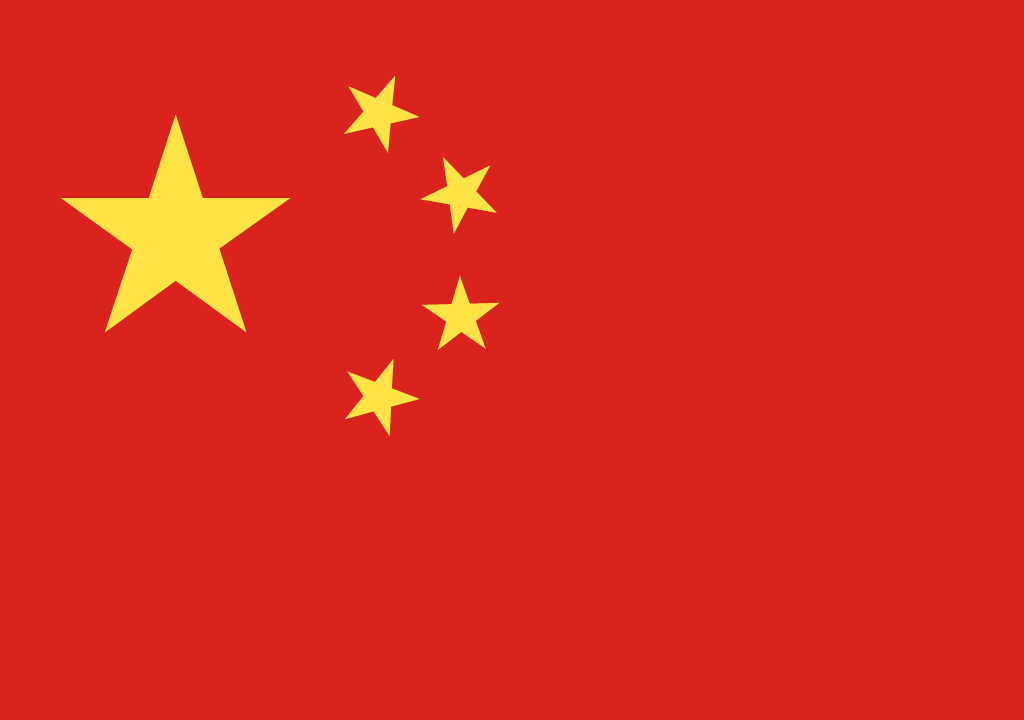
2 colors: red, yellow.
Meaning of the flag of China: Red is a traditional color in Chinese culture and also represents the communist revolution; the stars are yellow to represent the official color of the Manchu dynasty and to imply that China belongs to the Chinese people, a “yellow race”. The big star symbolizes the Communist Party; the four smaller stars represent the four social classes of the traditional Chinese society united under the Communist Party of China (working class, peasantry, urban petty bourgeoisie, national bourgeoisie or capitalists). The other potential meaning of the stars is to represent the five main ethnicities of China: the Han, Manchus, Mongols, Hui and Tibetans. The stars all have 5 points to reflect the importance of this number in Chinese philosophy, being associated with the five elements (Water, Fire, Earth, Wood, Metal) and therefore historically associated with the Emperor of China.
History of the Flag of China
The flag of the People’s Republic of China is red with a set of yellow five-point stars: a larger one with four smaller ones laid in a semi-circle on the right.
Red represents the Communist Revolution that followed the Second World War.
According to the official interpretation of the Communist Party, that rules the country, the stars symbolize the union of the Chinese people. In detail, Mao Tse Tung explained that the bigger star represents the Communist Party of China around which the social classes gather: farmers, factory workers, petite bourgeoisie, and national bourgeoisie. The layout of the stars is similar to the map of China.
Others claim the five stars also represent the five ethnic groups in the country: Han, Zhuang, Hui, Manchus, and Uyghurs.
The flag was officially adopted on 27 September 1949, putting aside many other competing designs. In one of them, very similar to this one, there was a sickle and hammer in the middle of the larger star. In another version, initially the favorite of Mao Tse Tung, the four smaller stars didn’t exist and there was a yellow stripe at the bottom of the flag, from left to right, that represented the Yellow River. But these are just a couple of examples among the several other proposals.
Flag of Cyprus
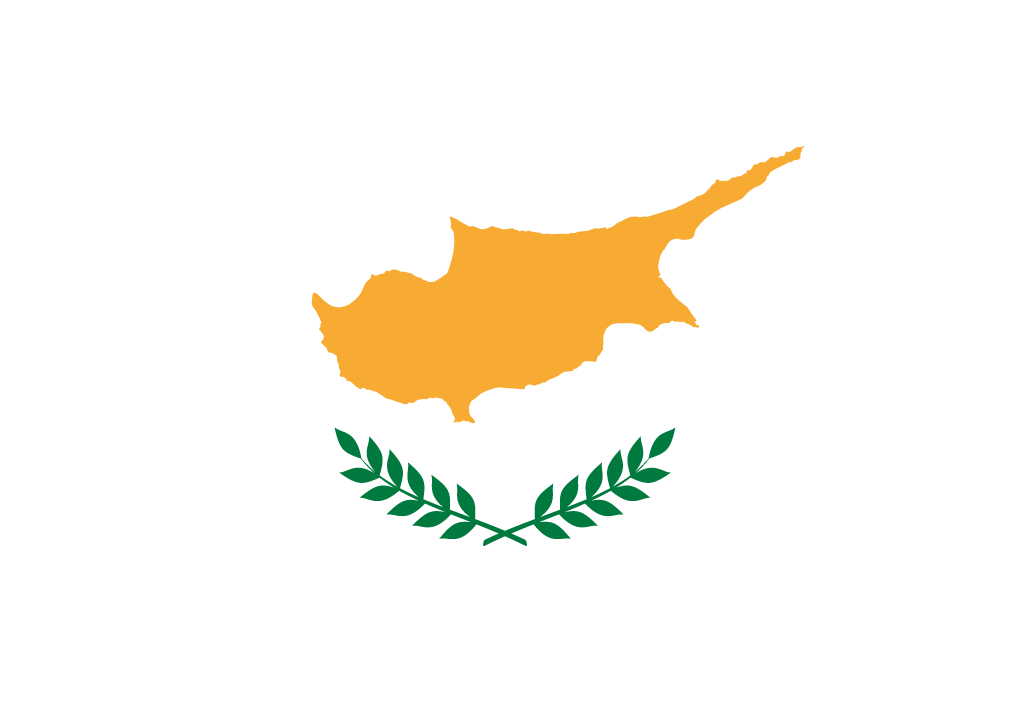
3 colors: white, orange, green.
Meaning of the flag of Cyprus: The white field of the background has a copper-orange island in the center, representing the abundance of copper ore in the country. Under the island there are two olive branches which symbolize the peace and harmony which the country has been trying to negotiate between the Greek and the Turkish communities. That is why the Constitution of Cyprus forbids the use of a cross or crescent and blue (Greek) and red (Turkish) colors in the Cypriot flag.
History of the Flag of Cyprus
The flag of Cyprus is mainly white with the country’s outline in the center in dark yellow. Underneath the shape, two branches cross.
The color chosen to represent the island’s map on the flag, symbolizes copper, Cyprus’ main natural resource. The name Cyprus is also based on the Greek word for copper.
The crossed branches symbolize peace, an always central topic in an island marked by conflicts between the Greeks and the Turkish, that ended with Turkey invading the island in 1974 and creating an independent area on the west side of the island.
An elementary school teacher designed the flag and it was approved by Cyprus’ first president Makarios III, according to criteria included in the Constitution that didn’t allow to use the same colors of the flags of Greece and Turkey, red and blue. There was an attempt to replace the flag in 2004, but a national referendum showed the population’s wish to keep the same design. That new flag was meant to have three horizontal stripes, blue, yellow, and red from top to bottom, separated by white lines.
The current flag was officially approved after the independence of Cyprus from the United Kingdom on 16 August 1960, with slight adjustments made later and approved one final time on 24 April 2006.
Flag of East Timor
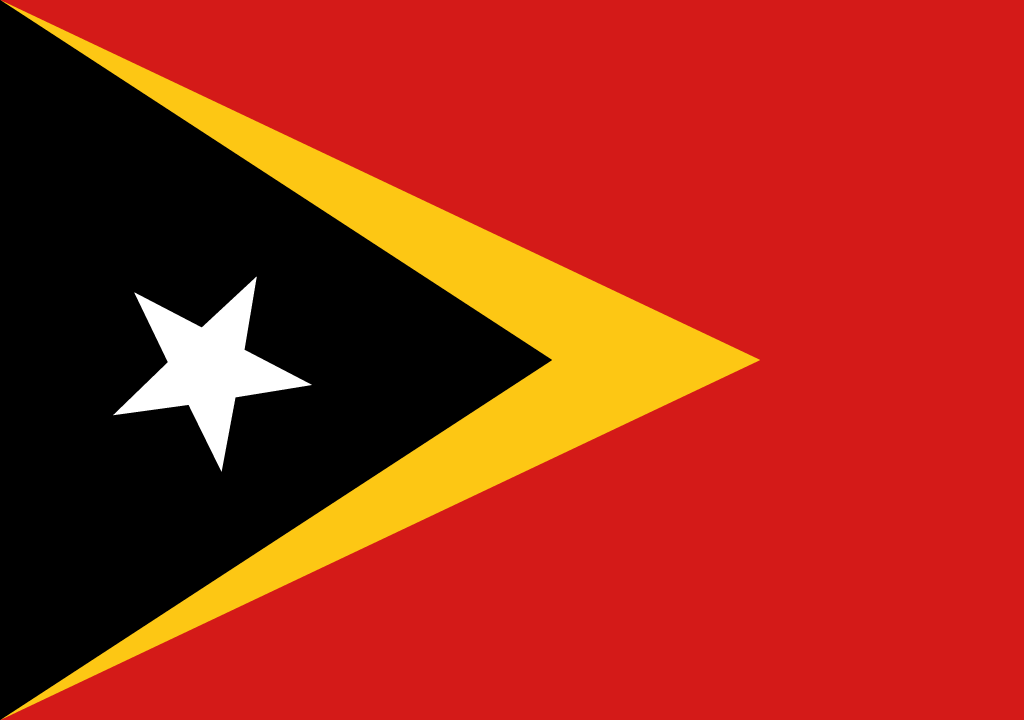
4 colors: red, yellow, black, white.
Meaning of the flag of East Timor: Yellow represents the traces of colonialism in the History of East Timor; black symbolizes the dissimulation that needs to be conquered; the red background represents the struggle for national freedom of Timor Leste. The five pointed white star represents peace.
History of the Flag of East Timor
The flag of East Timor is red with two overlapping triangles, with their base on the left and the vertexes pointing towards the center. The bottom triangle, smaller and more visible, is yellow and the top one is black. Laid over this triangle, there’s a white five-point star.
The flag’s background color symbolizes the blood shed during the fight for independence, while black is a reference to the colonial past. Yellow symbolizes hope in a better future, and the white star represents peace and freedom.
That flag, inspired by the main political party FRETILIN, was officially adopted in 1974 when East Timor gained independence from Portugal but the immediate invasion by Indonesia that followed didn’t allow them to use that flag.
It wasn’t until 19 May 2002 and the second independence, this time from their powerful neighbors, that East Timor could adopt the flag. It’s, therefore, one of the most recent flags in the world.
Flag of Georgia
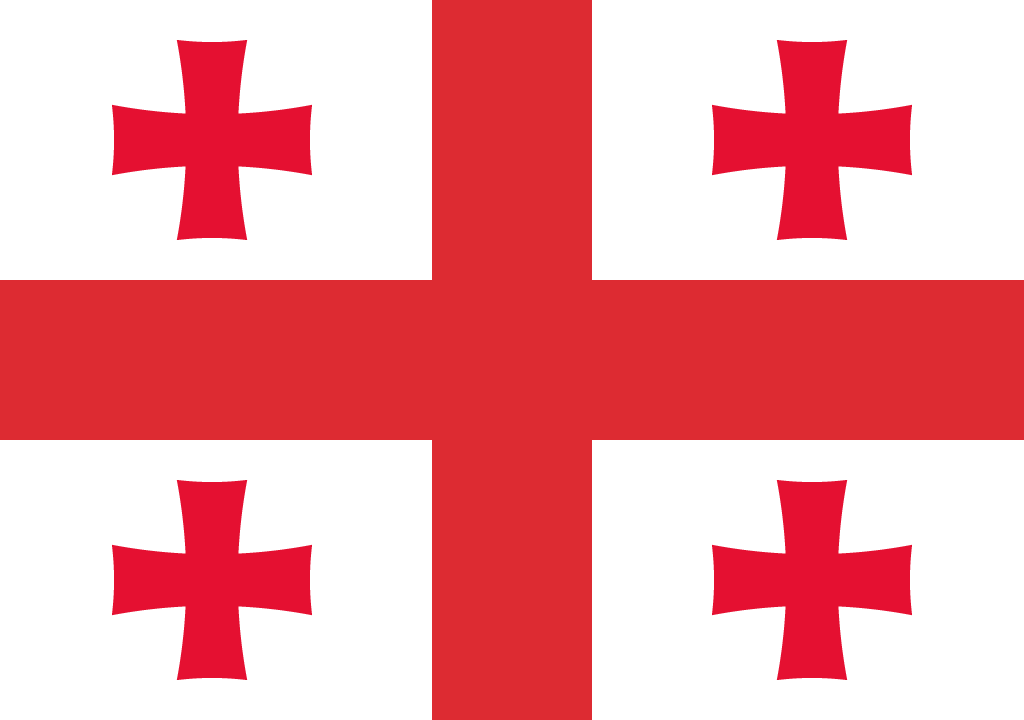
2 colors: white, red.
Meaning of the flag of Georgia: The flag of Georgia features a white background with a large red St. George’s Cross centered over it representing the Georgian kingdom in the 5th century. In each of the four white rectangles created by the cross there are 4 more red Blonisi crosses. All the crosses probably represent the five Holy Wounds that Jesus suffered during his crucifixion.
History of the Flag of Georgia
The flag of Georgia is very distinguishable with a white background and a red St. George’s cross, like the one used in the English flag, splitting the flag into four sections. On each of the four sections, there are smaller crosses, also red.
The origin of this flag is a political one: it used to be the flag of the National Movement, led by President Saakashvili, who became the leader of the country after the Revolution of Roses in 2002. However, the flag goes back at least to the 14th century, when a Franciscan monk described it as the flag of the kingdom of Georgia.
This is the last flag of several different flags used by Georgia in the last 120 years. In the 20th century alone, Georgia had seven flags including the ones imposed by the Soviet Union. After the collapse of the USSR and independence, Georgia began to use a mainly dark red flag, but it was never a popular option because it was always associated to the chaos and turmoil that followed independence.
The current flag was adopted officially on 24 January 2004, and it’s one of the most recent flags in the world.
Flag of India
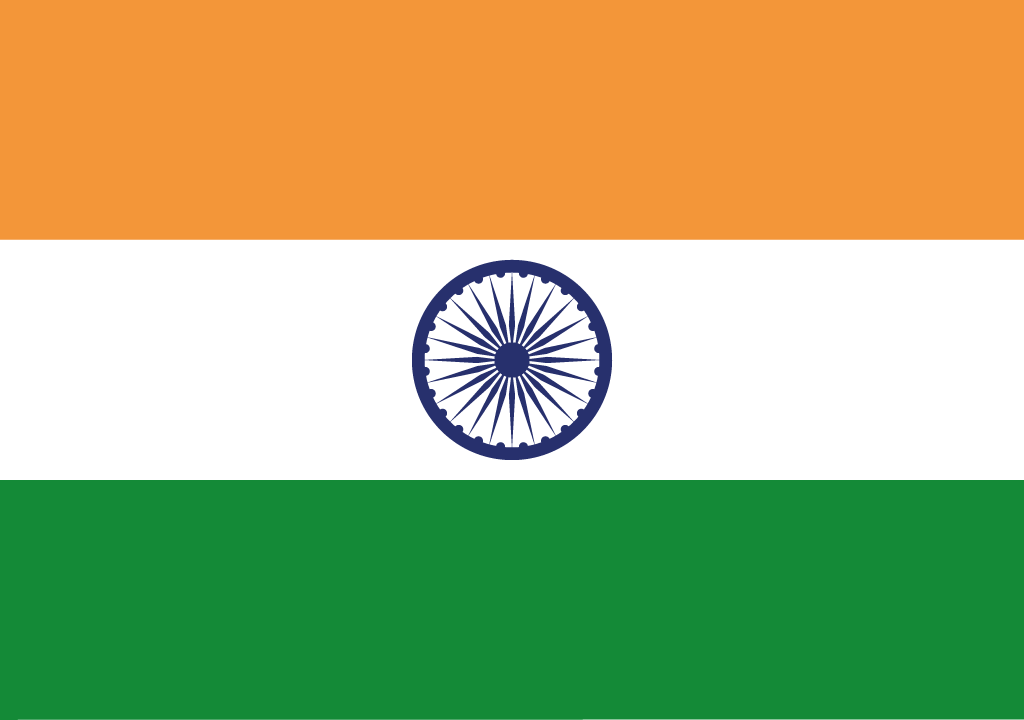
3 colors: orange, white, green.
Meaning of the flag of India: The three colors in the flag of India symbolize ideals cultivated by the constitution of India. Orange (or Saffron),stands for courage, sacrifice, valor and the spirit of renunciation; white is for truth, peace and purity of thought; green represents culture, fertility and faith. The “Ashoka Chakra “, the blue spinning wheel with twenty-four spokes, symbolizes the eternal wheel of progress and righteousness.
History of the Flag of India
India has a three-colored flag with horizontal stripes. From top to bottom: saffron, white, and green. In the center, laid over the white stripe, there’s an ancient symbol representing the sun in dark blue that’s historically connected with Brahmanism and god Vishnu. This symbol, which was mentioned for the first time in the 3rd century BC, replaced another one that depicted the wheel of a loom and that had been included by Gandhi in the first flag of modern India. That flag was proposed by Gandhi at the Indian National Congress in 1921 and was designed by Pingali Venkayya.
The flag was in the center of tensions between British controlled India and the ones fighting for independence. In fact, the flag presented by Gandhi played a key role in establishing a national identity, and the so-called “flag movement” gained momentum by being supported by even politically rival communities like the Muslim community.
The symbolism of the flag of India was defined in 1947 by philosopher Sarvepalli Radhakrishnan, who became president:
” Bhagwa or the Saffron denotes renunciation or disinterestedness. Our leaders must be indifferent to material gains and dedicate themselves to their work. The white in the center is light, the path of truth to guide our conduct. The green shows our relation to (the) soil, our relation to the plant life here, on which all other life depends. The “Ashoka Chakra” in the center of the white is the wheel of the law of dharma. Truth or Satya, dharma or virtue ought to be the controlling principle of those who work under this flag. Again, the wheel denotes motion. There is death in stagnation. There is life in movement. India should no more resist change, it must move and go forward. The wheel represents the dynamism of a peaceful change. “
The current flag was adopted when India became independent on 22 July 1947, after Nehru presented it to the Constituent Assembly. It was approved unanimously.
Flag of Indonesia
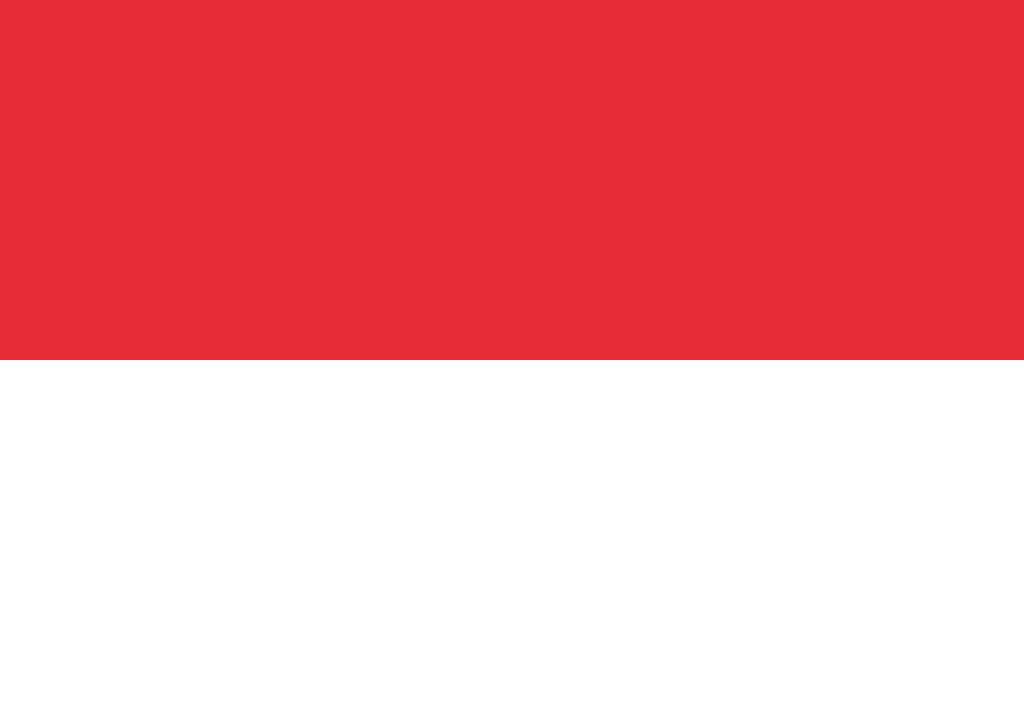
2 colors: red, white.
Meaning of the flag of Indonesia: Red stands for courage; white is for purity. Red can also stand for physical life, while white symbolizes spiritual life. These two colors combined make up humans. The flag of Indonesia has been named “Sang Saka Merah-Putih”, meaning the “Sacred Red and White”.
History of the Flag of Indonesia
COMING SOON…
Flag of Iran
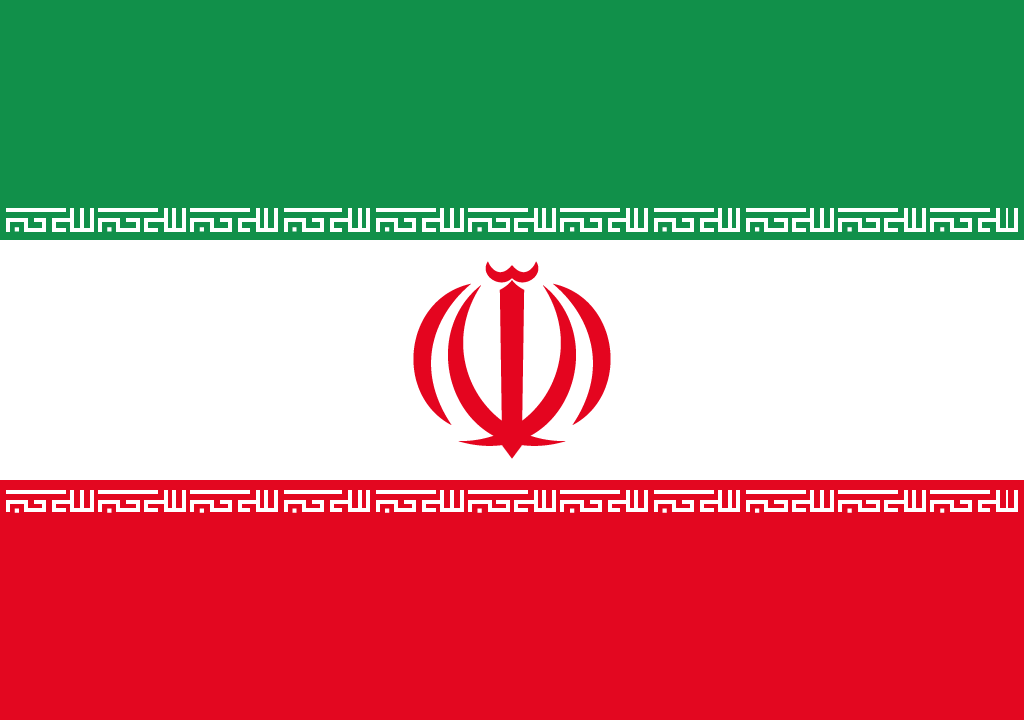
3 colors: green, white, red.
Meaning of the flag of Iran: The colors in the Iranian flag date back to the times when the Shahs dominated the country. Green symbolizes Islam and also stands for hope and aspirations for a better future; white is a traditional symbol of peace; red represents the courage that the Iranians treasure. The emblem is made up of four crescents with a sword in the center. The sword in the center represents the strength of the nation. To the bottom of the green band and top of the red band the takbir is written twenty-two times in the Kufic script. The takbir reads the phrase Allahu Akbar which translates into “God is greater than can be described.” The number twenty-two is significant as it refers to the Islamic Revolution that occurred on the twenty-second day of the eleventh month of the Iranian calendar.
History of the Flag of Iran
The flag of Iran has three horizontal stripes: green at the top, white in the middle, and red at the bottom. In the center, laid over the white stripe, there’s a symbol that represents a tulip in five parts, that correspond to the five pillars of Islam.
There are two lines separating the red and the green stripe from the white one, which have the inscription “God is Great” (known as takbir) repeated 11 times and written in Kufic characters, a classical way to write in Arabic.
In addition to being the color of Islam, green has a specific symbolism in the Iranian culture representing development, happiness, union, nature, vitality, and the languages spoken in the country.
The white represents freedom. It’s a color that can include all colors and that infinity of possibilities is what makes white the color of freedom.
The red, in addition to symbolizing martyrdom, also symbolizes bravery, fire, and sophistication in Iran.
The evolution and history of the flag of Iran are as long as the country’s history and, over the centuries, the country has shown different flags and different colors.
Between the 18th and 19th centuries, the flags had a triangular shape and only adopted the rectangular design in the Qajar Dynasty (1789-1925). This was also the time when the first flag of Iran with the colors we know today appeared for the first time. It was designed by Amir Kabir, the chancellor of Persia from 1848 to 1851. That flag had a very wide white stripe in the center, and the colorful stripes were as thin as lines. In the center, there was a yellow lion, an old symbol associated with Persia and Islam.
In 1886, the lion was still there, but the stripes’ proportions were closer to the current version. In 1906, after the Iranian Constitutional Revolution, the country adopted a flag that was almost the same as the current one. After 1907, the lion was kept only in the State flag, while the national flag was simplified to a three-color design that remained the same until the Islamic Revolution of 1979.
In 1980, the new regime changed the flag and introduced the symbol designed by Hamid Nadimi. The current flag was adopted on 29 July that same year.
Flag of Iraq
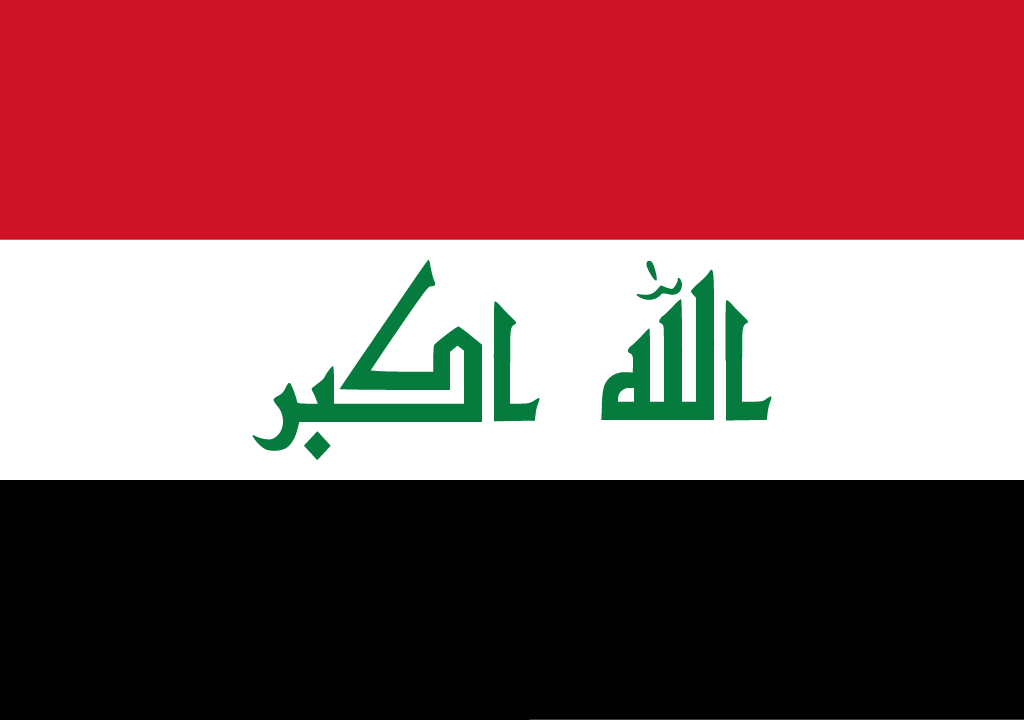
3 colors: red, white, black.
Meaning of the flag of Iraq: Red represents the bloody struggle and the courage to overcome it; white signifies the bright future for Iraq and the generosity of Iraqis; black symbolizes oppression against Islam and the triumph of Islam. The green of the Takbir (which reads “Allahu Akbar”, “God is greater than can be described”) represents Islam as it is believed to be a favorite color of Prophet Muhammad and his daughter, Fatima. Green is also mentioned several times in the Quran, in relation to paradise.
History of the Flag of Iraq
The flag of Iraq has the colors of the Pan-Arab movement in a basic three-color design with three horizontal stripes: red at the top, white in the middle, and black at the bottom. In the center, in Arabic, the inscription “God is Great” in green, written in Kufic, an old writing style.
The symbolism of those colors is the same in many Arab countries. Red means bravery, white means generosity, and black means victory. Green is the traditional color of Islam.
The Iraqi flag first appeared in 1921, when the first flag of the Kingdom of Iraq appeared, influenced by the Arab Liberation (1916-1918) when the Ottomans were ousted from Middle Eastern areas where Arabs lived. That first flag resembled the one used by Jordan today and was used until 1958.
That year, and after the political union with Syria and Egypt, Iraq joined Jordan and adopted a common flag. However, things changed six months later with the Iraqi Revolution that abolished the monarchy regime in the country. After four years using a different flag, despite being based in the same color scheme, Iraq adopted a flag in 1963 that would be in use until 1991. It was very similar to the current one but with five green five-point stars in the center.
Between 1991 and 2004 the inscription “God is Great” was used in the flag, in the handwriting of the country’s leader Saddam Hussein. The end of his regime meant a change and the inscription remained but now written in Kufic script.
In 2008, the flag took its current design, removing the three green stars, and was officially adopted on 22 January that same year.
Flag of Israel
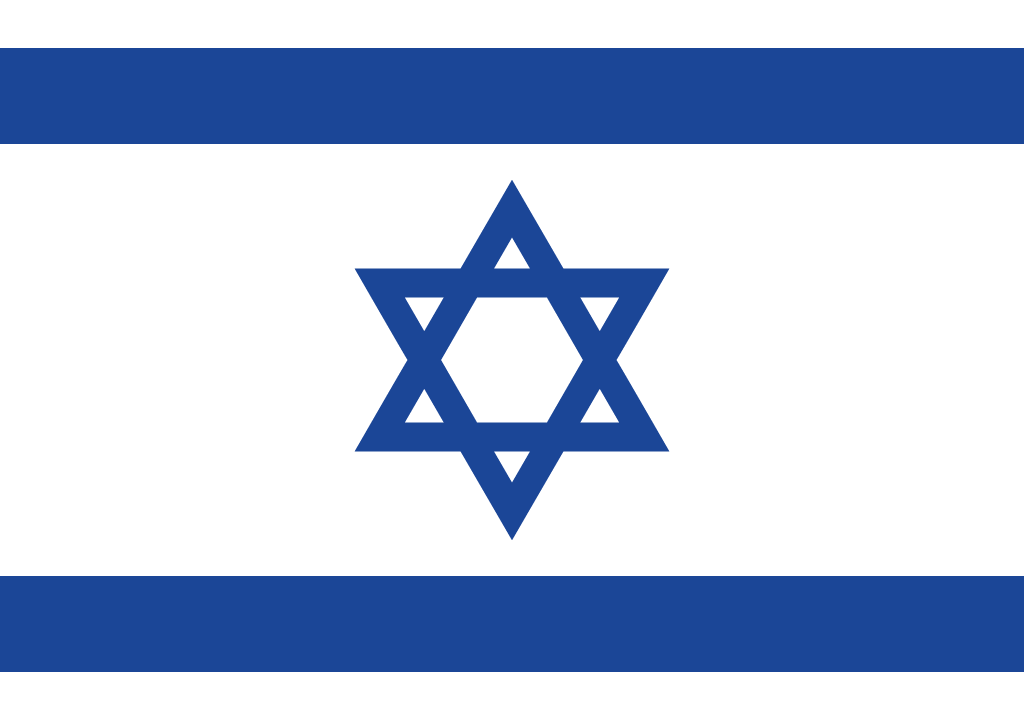
2 colors: white, blue.
Meaning of the flag of Israel: The basic design of the flag of Israel remembers the Tallit, the Jewish prayer shawl in white with blue colored stripes. On the white part of the flag there is a blue Star of David, composed by two crossing equal blue triangles, from the Biblical times a common symbol of the People of Israel. The Star of David is also known as the Jewish star and is a symbol of Judaism. A more modern interpretation of the Israeli flag identifies the blue and white stripes representing purity, guided by the principles of the Torah, and the Star of David representing a new beginning for Israel.
History of the Flag of Israel
The flag of Israel has only two colors: blue and white. There are two narrow stripes at the top and the bottom, and a much wider white stripe in the center. Laid over that central stripe is a six-point Star of David in blue.
The choice of colors symbolizes Zionism’s expression of purity and the sky. The blue, in general, symbolizes the divine glory and the strictness of God, while white represents God’s generosity.
The blue stripes are a representation of the tallit, a shawl that’s used by Jewish when praying. The star, a symbol of Judaism for over 700 years, was in the ring of King Solomon and is also known as the Seal of Solomon.
The flag of Israel goes back to the end of the 19th century when the Zionist movement tried to create a Jewish State in Palestine. In 1897, at the time of the First Zionist Congress in Basel, Switzerland, Morris Harris, a member of the New York Hovevei Zion, designed the flag that was later manufactured by his mother, Lena Harris.
The next year, at the Second Zionist Congress, it was decided to accept that flag as the official flag of Zionism. When the State of Israel was founded in 1948, they adopted the current flag, on 28 October of that year.
Flag of Japan
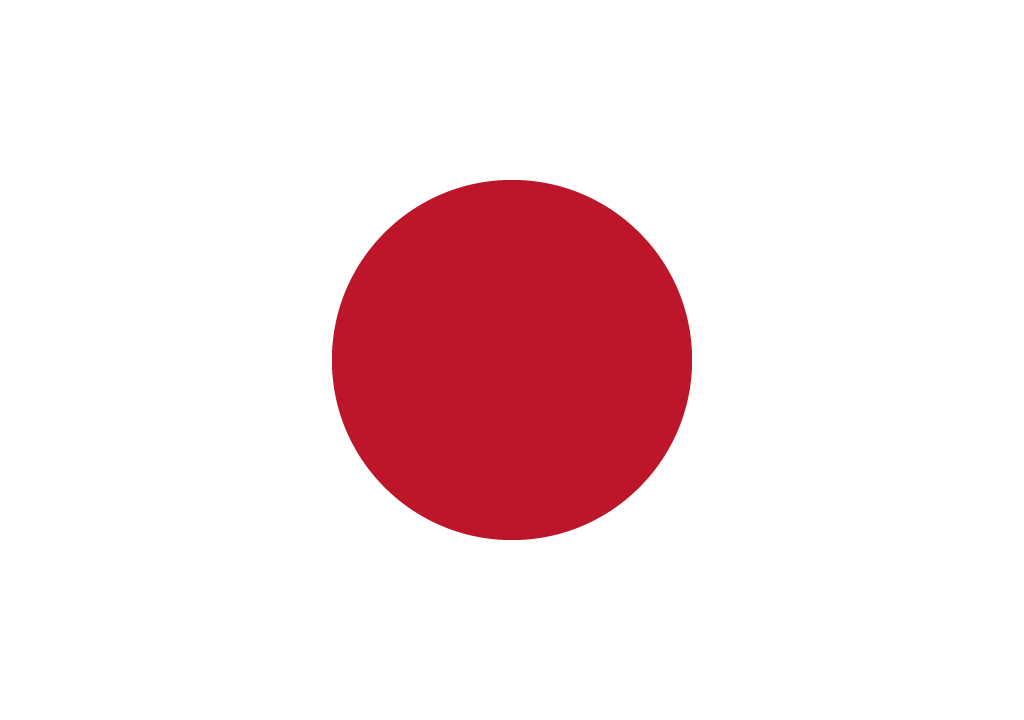
2 colors: white, red.
Meaning of the flag of Japan: The Japanese flag symbolizes Japan’s location in the east of Asia, where the sun rises. Japan is called “Land of the Rising Sun”. So, the sun goddess ‘Amaterasu’, founder of Japan and ancestor of its emperors, is represented by the red disc in the center. It symbolizes the bright future for Japan, while white represents honesty, integrity and purity of the Japanese people.
History of the Flag of Japan
The flag of Japan is white with a red circle in the center. Japan is known as the country of the rising sun, and that’s precisely what the red circle represents. The symbol that has been associated with Japan for centuries is called Hinomaru by the Japanese. The cult of the sun has always been very important in Japan, and it was believed that the Japanese emperors were the descendants of the sun goddess Amaterasu.
The symbol that’s now part of the current flag was already used by samurais in the 12th century and was used as a military symbol for centuries. When in 1870 Japan began to open up to the rest of the world, leaving behind their isolationism politics they’d been following for a long time, they immediately adopted the current flag.
Flag of Jordan
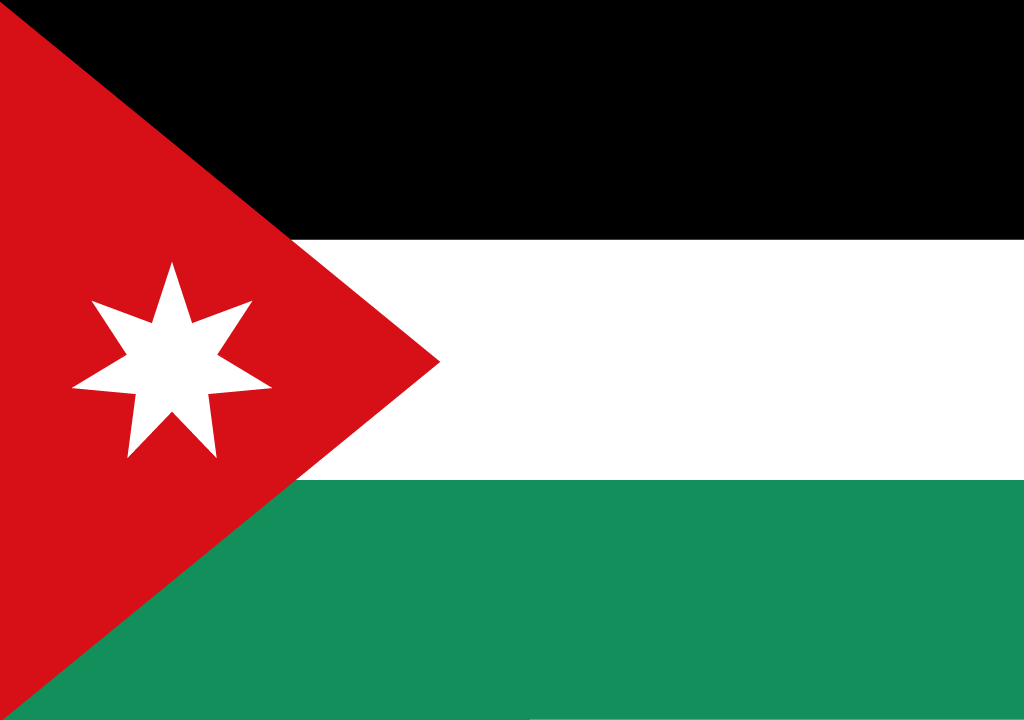
4 colors: black, white, green, red.
Meaning of the flag of Jordan: The colors of the stripes in the flag of Jordan represent the historical dynasties of the region. Black symbolizes the Arab Abbasid dynasty; white stands for the Umayyad dynasty; green is for the Fatimid dynasty; red stands for the Hashemite Emirate, the precursor to the current Hashemite Kingdom of Jordan. Each of the points of the star symbolizes one of the pillars of Islam, the seven verses of the first surah of the Qur’an, called the Fatihah.
History of the Flag of Jordan
The flag of Jordan has three horizontal stripes: black at the top, white in the middle, and green at the bottom. On the left side, there’s a red triangle laid vertically with the base covering all of the flag’s left side and the vertex pointing towards the middle. Laid over that triangle, there’s a seven-point white star.
The set of colors is associated with the Pan-Arab movement and the flag used in the Arab Revolution (1916-1918) against the ruling of Middle Eastern areas inhabited by Arabs by the Ottoman Empire.
The colors of the stripes represent three important caliphates: black is for the Abbasid, white is for the Ummayad, and green is for the Fatimid. The red represents the Hashemite dynasty that rules Jordan.
The star was added when the flag was officially adopted on 18 April 1928, and it represents the union between all Arab people. The seven points represent the seven hills on which Amman, the country’s capital, was built but also symbolizes the faith in one single god, humanity, humbleness, national spirit, virtue, social justice, and aspiration.
Flag of Kazakhstan
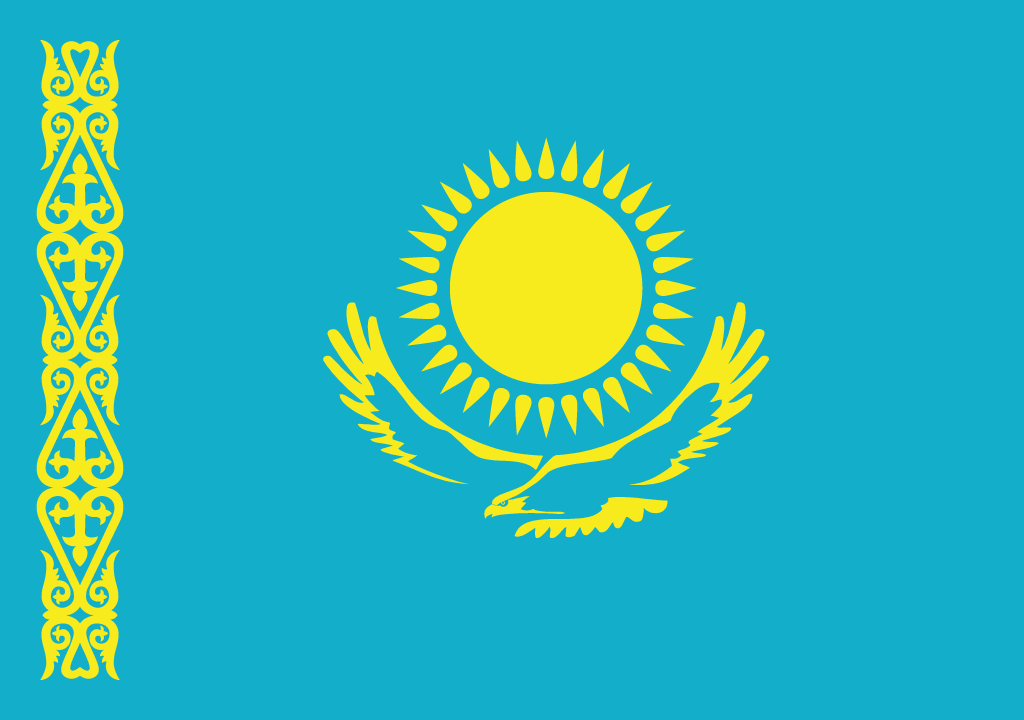
2 colors: blue, yellow.
Meaning of the flag of Kazakhstan: The solid blue background means peace and unity of people living in Kazakhstan, as well as the infinite, pure sky. The sun represents the source of life and energy but is also a symbol of progress and movement for nomads. The silhouette of the sun is a symbol of well-being and abundance. 32 beams come out of the sun, shaped like a grain to symbolize abundance and prosperity. The eagle represents the power of the state and astuteness. Also, for people living in the steppe, this bird of prey symbolizes independence, freedom, aspiration and, at the same time, strength to overcome any obstacles and difficulties. The ornament on the left identifies the culture and traditions of Kazakhstan.
History of the Flag of Kazakhstan
The flag of Kazakhstan is mainly light blue with a yellow symbol in the center: a steppe eagle, known locally as berkut, flying under a sun with 32 beams.
On the left side, there’s a national pattern of Kazakhstan in yellow across the flag from top to bottom.
The shade of blue used in the flag is common among the nomadic people of Central Asia and has been always present in the flags of Kazakhstan. In the flag, it represents peace, freedom, ethnic and cultural union of all the people living in the country, that form a more significant, more complicated cluster of six different groups. The sun symbolizes energy and life, abundance and wealth. The eagle symbolizes the State, as a pillar of national independence, freedom, and an enabler of great flights towards the future.
Although it’s a recent national flag, it’s inspired by ancient traditional symbols. It’s likely that the flag of the Kazakh Khanate wasn’t much different and had the same shade of blue. Even when the country was part of the Soviet Union the flag had a stripe with that same color, and over the centuries the flags of different tribes in the area featured a golden eagle.
The current flag was officially adopted on 4 June 1992, about two years after the country’s post-Soviet Union independence.
Flag of Kuwait
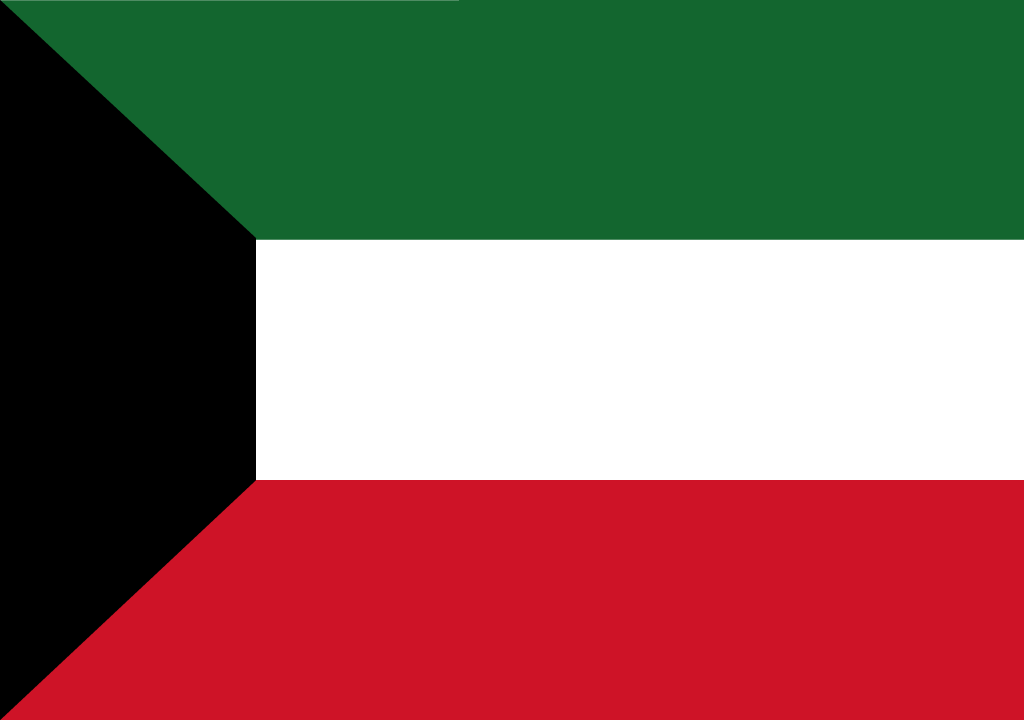
4 colors: green, white, red, black.
Meaning of the flag of Kuwait: The colors of the flag of Kuwait make up the pan-Arab colors, a combination used in the Arab world which represents the various dynasties that once ruled the region. Red symbolizes the Hashemites; green is for the Fatimid dynasty; white represents the Ummayad dynasty; and black symbolizes the Abbasid dynasty (or possibly the prophet Mohammed). On the flag of Kuwait, green represents the fertile lands and meadows of the region; white is for purity and deeds; red is for the blood and the heroism of the soldiers who have fought for Kuwait; black represents the defeat of enemies.
History of the Flag of Kuwait
The flag of Kuwait uses the same color scheme as the Pan-Arab movement, born from the flags used during the Arab Revolution in 1916.
It has three horizontal stripes: green at the top, white in the middle, and red at the bottom. On the left side, there’s a black trapezium with its base covering the flag from top to bottom.
In addition to the historical symbolism of the colors, in the country’s history white symbolizes the actions, black symbolizes the fights, green symbolizes the fields of Kuwait, and red symbolizes the swords used to defend the nation. Another interpretation, based in the popular Arab poem, claims green is fertility, white is peace, red is noble actions, and black is the battlefield.
The current flag was adopted on 7 September 1961, and it’s completely different from previous Kuwait flags that had been mainly red since the 18th century, which happened with most of the countries at the Persian Gulf.
Flag of Kyrgyzstan
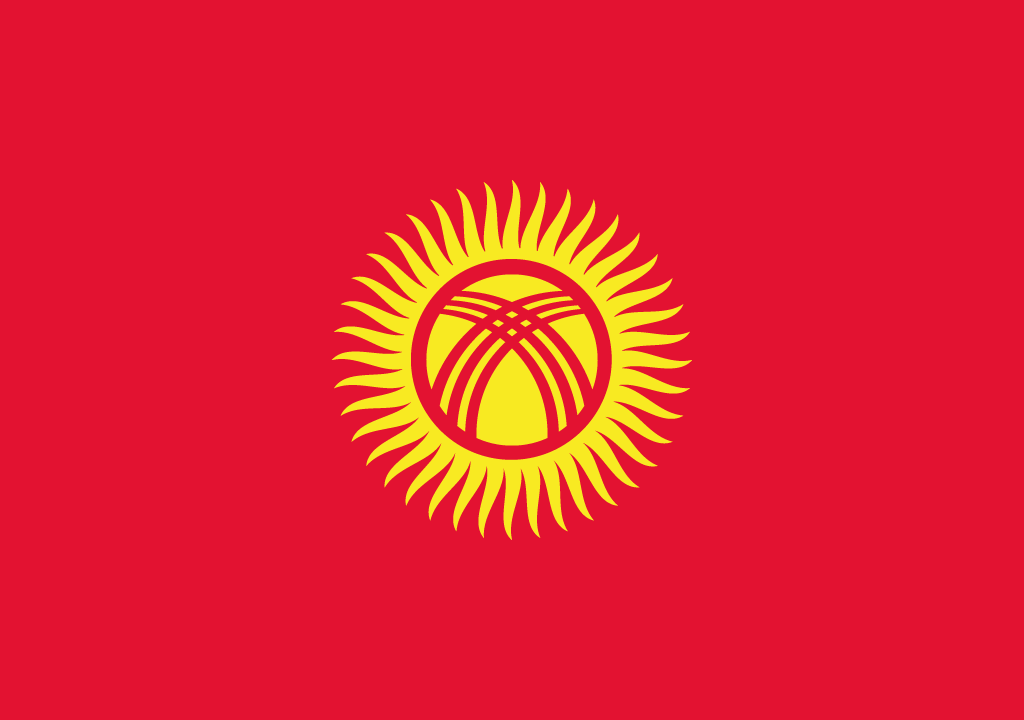
2 colors: red, yellow.
Meaning of the flag of Kyrgyzstan: The red background symbolizes the bravery and valor of the people; the yellow sun is for peace and wealth. Coming from the sun, there are 40 rays representing the 40 Kyrgyz tribes. The two sets of three lines crossing the sun are a stylized representation of a “tunduk”, the crown of a traditional Kyrgyz roof.
History of the Flag of Kyrgyzstan
The flag of Kyrgyzstan is mostly red with a yellow sun laid over.
The predominance of red is probably connected to Manas, an epic hero who is said to have gathered all the tribes in Kyrgyzstan under one common nation. According to the legend, the flag of this national hero was the same color. However, red also symbolizes bravery and value.
As for the sun, it has 40 small sunbeams that represent the 40 tribes of Kyrgyzstan and also the 40 followers of Manas. The sun also represents prosperity and peace. The symbol also contains an abstract representation of the roof of a yurt seen from the inside, the traditional house of the Central Asian people. Its presence on the flag symbolizes the origins of life, the union between time and space, and the importance of a comfortable home.
Over the last few years, there’s been some debate about the possibility of changing the flag, ironically because different interpretations of its symbols have caused some tensions in the country.
The current flag was adopted on 3 March 1992, about one year after the declaration of independence that followed the collapse of the Soviet Union.
Flag of Laos
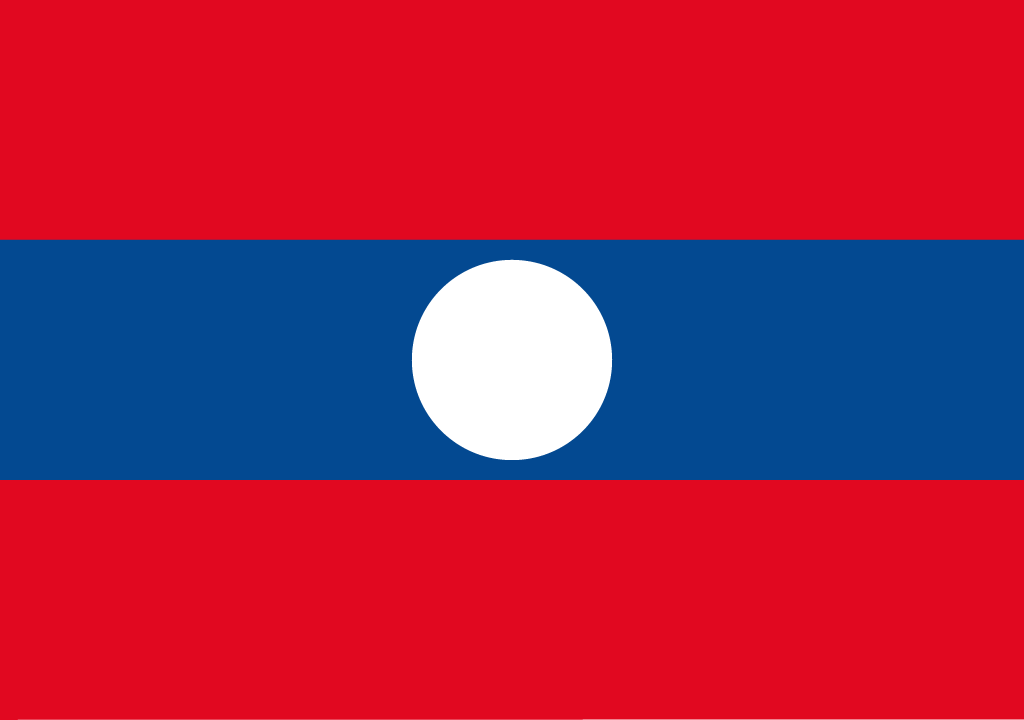
2 colors: red, blue.
Meaning of the flag of Laos: Red stands for the bloodshed and sacrifice in the freedom struggle; blue symbolizes the resources of the country. The white moon is the moon over the Mekong river.
History of the Flag of Laos
The flag of Laos has a white circle in the center and three horizontal stripes: a more wide, dark blue stripe in the middle, and two narrow red stripes at the top and the bottom.
The circle represents the national union and the full moon shining over the Mekong River, represented by the wide blue stripe. The red stripes symbolize the blood shed during the fight for freedom.
This flag was adopted for the first time after the Second World War on 12 October 1945, but soon after Laos reinstated the centuries-old symbols, inherited from the Kingdom of Luang Prabang, with a red flag and three elephants.
In 1975, after the Vietnam War was over and political forces supported by communist powers controlled the region, Laos was ruled by the Pathet Lao political party.
That political party had adopted the flag of the short-lived government of Lao Issara (1945-1946) and adopted it as Laos’ official national flag on 2 December 1975.
The flag of Laos has one particularity: it’s one of the two communist countries’ flags without a symbol that represents that political ideology. The other one is the flag of Cuba.
Flag of Lebanon
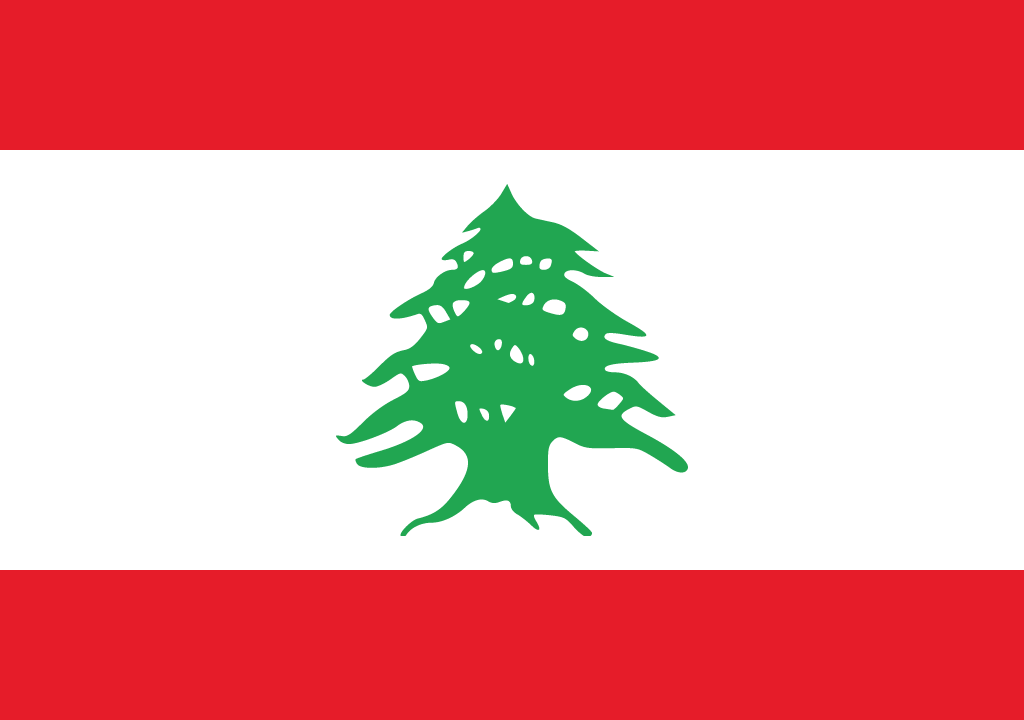
3 colors: red, white, green.
Meaning of the flag of Lebanon: Red represents the blood spilt in the freedom struggle; white symbolizes peace. The cedar tree is the symbol of steadiness and immortality.
History of the Flag of Lebanon
The flag of Lebanon has three horizontal stripes: two red ones at the top and bottom, and one wide white in the middle with the symbol of a cedar tree, Lebanon’s national tree, in green.
The symbolism of the cedar goes back to the biblical ages and represents holiness, eternity, and peace.
The white is a symbol of snow, that you can see in the country’s highest peaks, but also peace and purity. The red symbolizes the blood shed while defending Lebanon from continuous invasions.
The flag was an improvised design by members of the parliament during the declaration of independence on 7 December 1943.
Flag of Malaysia
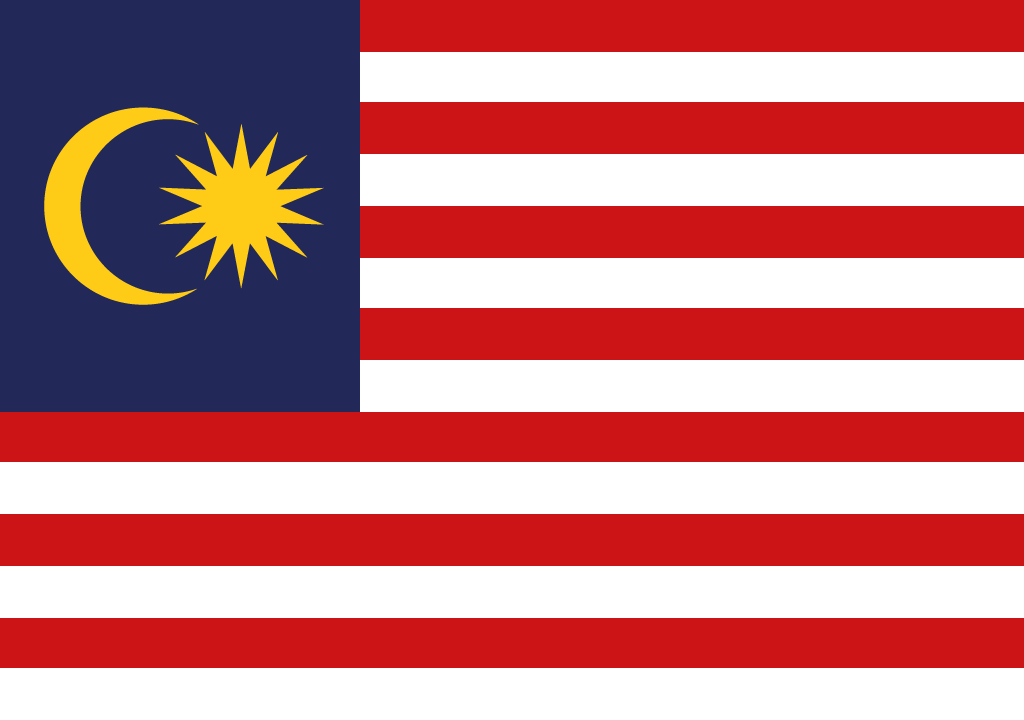
4 colors: red, white, blue, yellow.
Meaning of the flag of Malaysia: Blue stands for the unity of the Malaysian people and was originally adopted from the British Union Jack, representing Malaysia’s link to Britain; yellow represents the royal color of the Malay rulers and also the unity of the federal government and a group of thirteen states, represented by the fourteen red bands. The crescent and star imagery represent Islam. The name of the Malaysian flag is “Jalur Gemilang”, meaning “stripes of glory”.
History of the Flag of Malaysia
The flag of Malaysia has a series of horizontal stripes, resembling the design of the flag of the United States of America. It has a total of 14 stripes representing the 13 members of the Malay federation plus the territory of Kuala Lumpur, the capital.
On the top left corner, there’s a dark blue square with a yellow Crescent Moon and a 14-point star.
The colors of the flag are a reference to the Commonwealth, the community of English-speaking countries of which Malaysia is part of, except the yellow, which is a color traditionally related to the regions’ royal power.
The star and the Crescent Moon are symbols of Islam, the country’s main religion, but the star also symbolizes the union between the States that are part of the federation.
The flag was designed in 1947 by a young architect, Mohamed Hamzah, who worked for the government at the time. He entered a national competition with two designs he created under two weeks, and the people picked one of his ideas, among 373 applications.
That was inspired by the flag of the British East India Company, except the star of that first flag had 11 points, and the number of stripes increased in 1963 to reflect the updated number of the federation states.
The flag was officially adopted on 26 May 1950 and changed into the current design on 16 September 1963.
Flag of Maldives
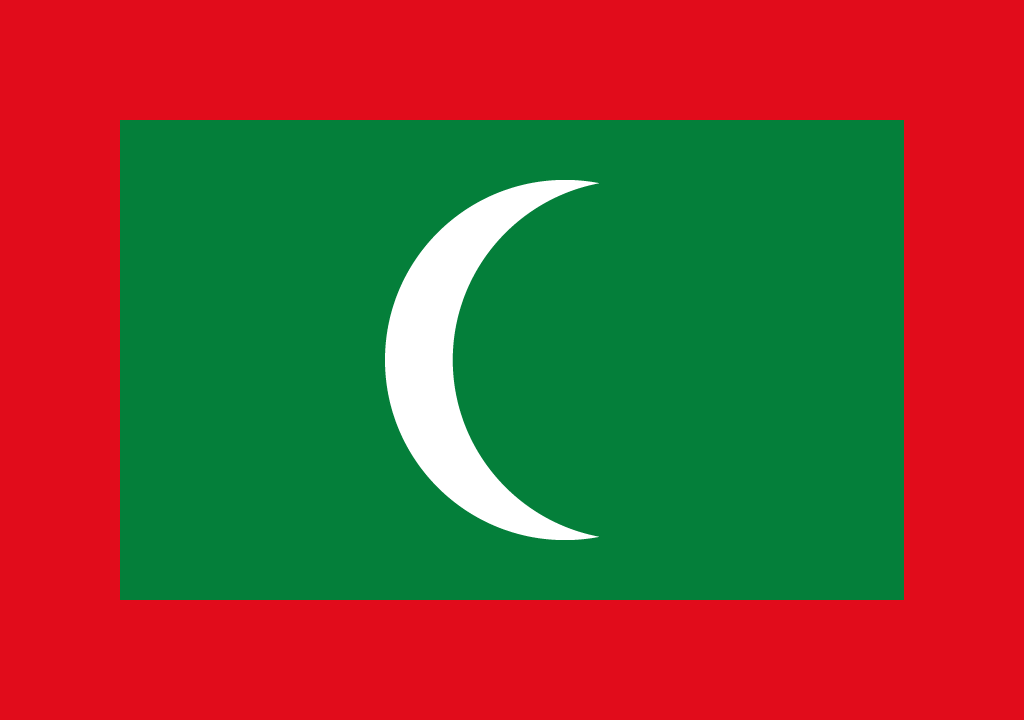
2 colors: red, green.
Meaning of the flag of Maldives: Red symbolizes heroes who have sacrificed their lives in defense of the country’s independence and sovereignty; green represents peace, prosperity and the wealth of palm trees; the white crescent symbolizes the Islamic faith of the island nation.
History of the Flag of Maldives
The flag of Maldives has a red background with a green square covering all the central area. There’s a white Crescent Moon in the middle of that square.
The red symbolizes the most common: the blood that was shed during the fight for independence. The green has a religious meaning because it’s the color of Islam, the country’s main religion, but it’s also associated with progress and peace. The Crescent Moon reaffirms Islam’s importance in the Maldives.
The flag of the archipelago has always been traditionally red. Up until 1903, the flag was completely red, but it changed a bit since then. That year, they added a thin vertical stripe on the left side with diagonal black and white lines. In 1926, they added the Crescent Moon. In 1953, they added the green square. And in 1965, when the Maldives gained independence from the United Kingdom, the flag took its current shape, removing the side stripe. It was officially adopted on 25 July that year.
Flag of Myanmar
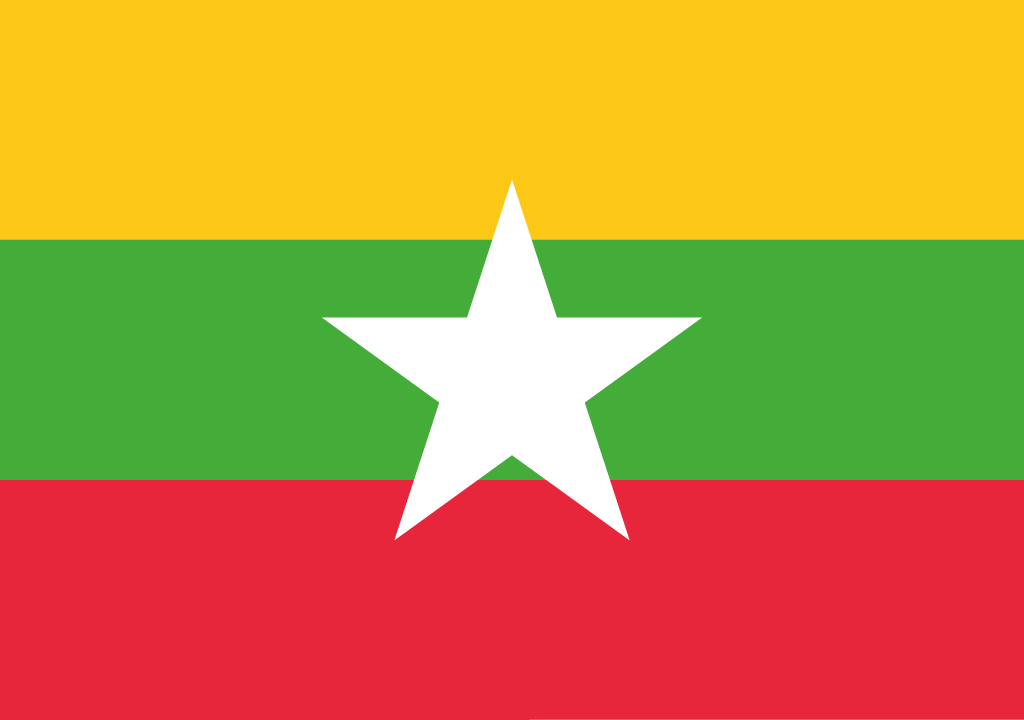
3 colors: yellow, green, red.
Meaning of the flag of Myanmar: Yellow signifies solidarity among all ethnic groups; green represents peace, tranquility and the nation’s environment; red symbolizes courage and decisiveness. The white star represents the consolidated union.
History of the Flag of Myanmar
The flag of Myanmar has three colors in three horizontal stripes: yellow at the top, green in the middle, and red at the bottom. There’s a big white five-point star in the middle.
This flag was inspired by the old flag used in Burma (Myanmar’s former name) at the time of the Second World War.
The yellow stripe symbolizes solidarity between the peoples of Myanmar, green symbolizes the country’s natural resources, and the red symbolizes the courage of its people during the several wars they’ve been involved in.
The white star symbolizes hope and the union of all the communities that live in the territory. However, despite the positive symbolism of the flag, interpretations are far from being consensual, and many people connect the flag with the policies of the forced assimilation of ethnic minorities.
The flag is recent, adopted on 21 October 2010, replacing another one that was mainly red and had white and blue elements, and that had been in use with several changes over the years since the end of the Second World War.
Flag of Mongolia
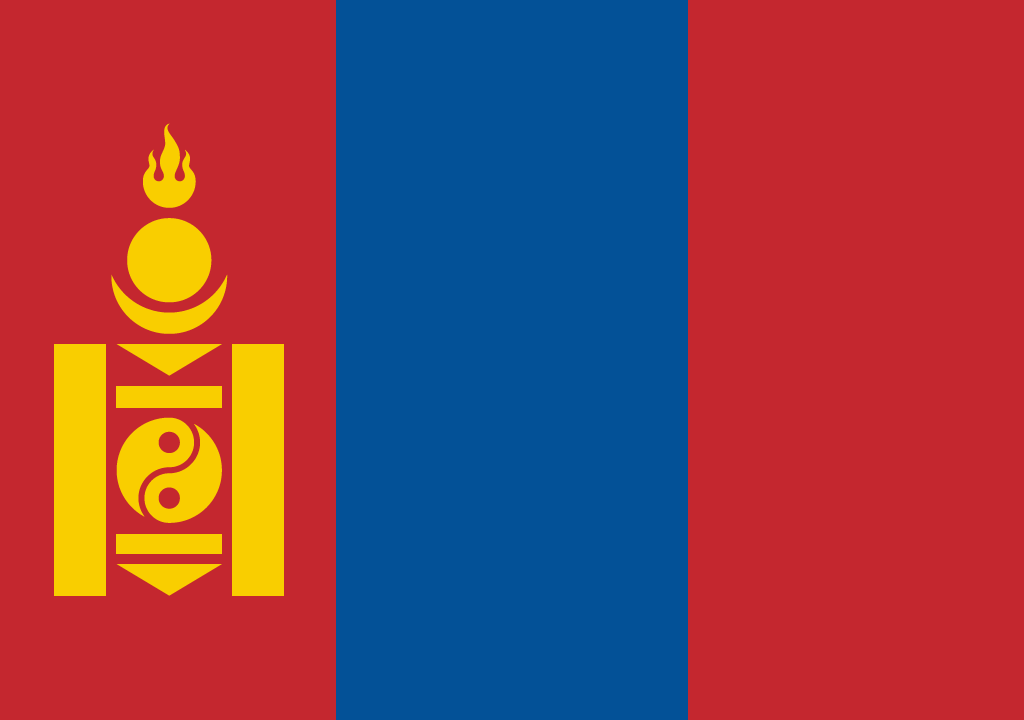
2 colors: red, blue.
Meaning of the flag of Mongolia: Red symbolizes Mongolia’s strength and harsh environment; blue stands for the blue sky. The soyombo symbol is a character in the Mongolian script and is also found on the coat of arms of Mongolia. It is composed by many symbols. At the top there is a flame, representing growth and wealth. Each tongue of the flame stands for time (past, present and future). Under the flame there is a sun over a crescent moon, representing Mongolia’s eternal existence. The two triangles pointing down next to rectangular bands represent spears defeating enemies. In the middle of the soyombo is the yin-yang symbol (Taijitu), showing balance and the complement of men and women. On either side of this column of symbols is a long upright rectangle which serves as fortress walls which stabilizes and strengthens everything inside.
History of the Flag of Mongolia
The flag of Mongolia has three vertical stripes: two side stripes in red and one blue in the middle. Laid over the left side stripe, there’s a unique symbol, in yellow, that’s called soyombo.
That symbol is ancient and has ties to Buddhism. There are three flames at the top that represent past, present, and future. There is also a sun and a moon that symbolize the world and eternity. The symbol also includes the yin and the yang that represent the dualism of opposites. There are two walls on both sides, a symbol of friendship in Mongolia.
As for the colors, blue symbolizes the eternal heaven and red symbolizes endless prosperity.
The current flag was adopted on 12 February 1992 after the independence of Mongolia that followed the collapse of the Soviet Union. However, the flag of the Soviet Mongolian’s People Republic was very similar with just one added element: a yellow five-point star over the soyombo.
Flag of Nepal
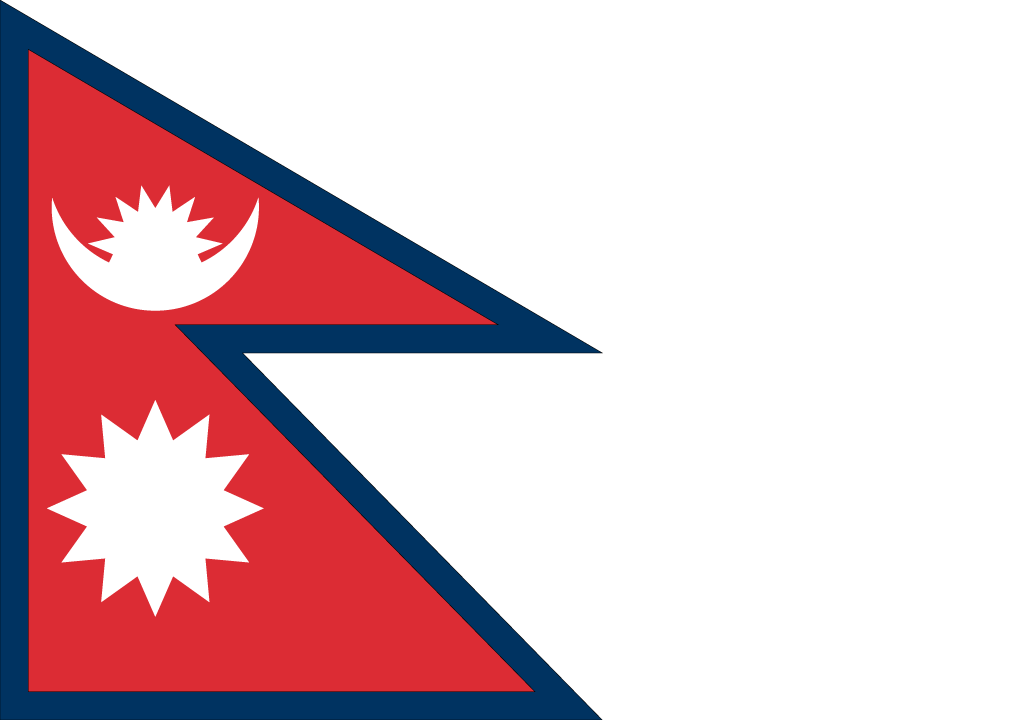
3 colors: red, blue, white.
Meaning of the flag of Nepal: It is said that the flag of Nepal foresees that the nation will last as long as the sun and moon are on earth. The blue part of the flag symbolizes peace; red represents the rhododendron, the national flower of Nepal. The curved moon stands for the royal house; the sun is for the Rana dynasty.
History of the Flag of Nepal
Nepal is the only country in the world with a flag that’s not shaped as a rectangular or a square. It has the peculiar shape of two orthogonal triangles, stacked on top of each other, with blue borders.
The top triangle has the silhouette of a moon, and the bottom triangle has a 12-point star that symbolizes the sun. The flag is actually the combination of two pennons used in Nepal from ancient times, probably going back over 2,000 years.
The format was adopted after the unification of Nepal’s principalities led by Prithvi Narayan Shah, in the mid 16th century, but the current symbolism of the flag has evolved since then.
The red is the same color as the rhododendron flower, Nepal’s national plant, and it represents the bravery of the Nepali people. The blue symbolizes peace and harmony and both colors are frequently seen together in everyday Nepali life, mostly for decoration and artistic purposes.
The triangles in the flag also represent the Himalayas and the two most important families in the country’s History: the Shahs, represented by the top triangle, and the Ranas, represented by the bottom triangle.
Another common interpretation connects both triangles to peace and hard work, but the official version relates them to the country’s two most important religions, Hinduism and Buddhism.
The celestial bodies represent longevity. In addition to that, the moon not only symbolizes the calm nature and the pure soul of the Nepali people, but also the crisp air of the mountains, and the sun represents the Nepali bravery and the warmth of the country’s lower lands.
The current flag was adopted on 16 December 1962, when a new constitutional government was inaugurated. At that time, they removed from the flag the human faces on the symbols of the moon and the sun.
Flag of North Korea
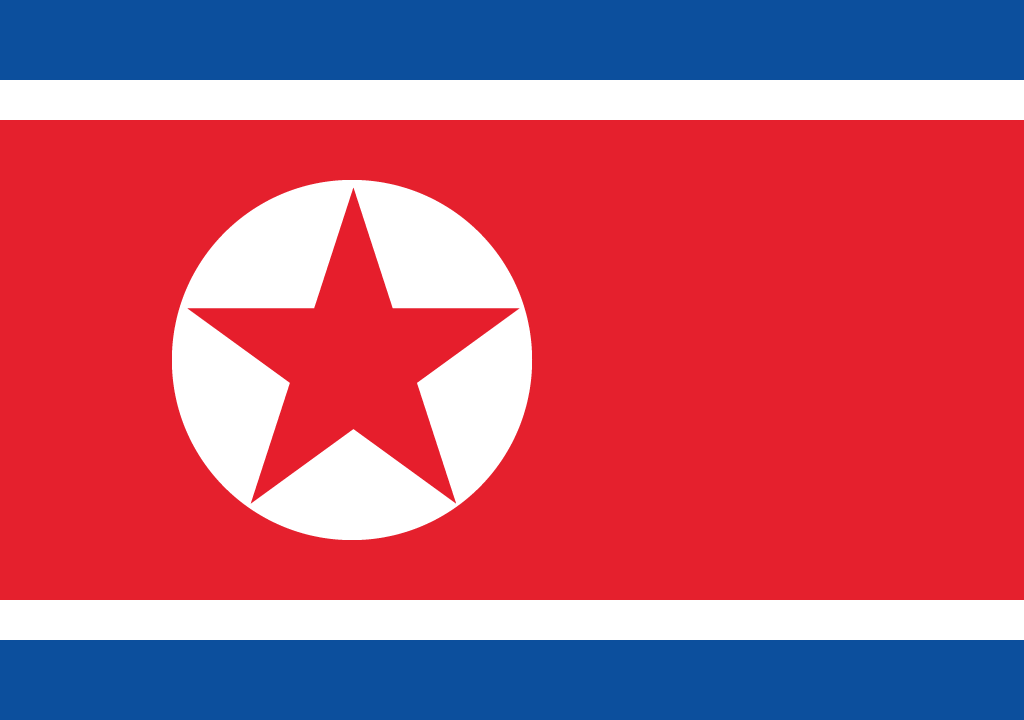
2 colors: blue, red.
Meaning of the flag of North Korea: Red stands for the revolutionary ideals and the patriotic spirit shown by the country men during the fight for independence; blue represents the nation’s independence and people’s desire to maintain peaceful relations with the progressive nations of the world; white is for homogeneous nature, purity and transparency of the people of Korea. The white disk is a representation of the opposing principles of nature and also refers to the yin-yang symbol. This disk also refers, according to ancient traditions, to the traditional Korean T’aeguk, symbol of the universe. The red star represents Communism and the role of the Korean Workers Party in transforming the nation into a better economic and political power during the turbulent period of the Second Civil War.
History of the Flag of North Korea
The flag of North Korea has three horizontal stripes: a wider red stripe in the center and two narrow blue stripes at the top and the bottom. Two thin white lines separate the red stripe from the blue stripes. Laid over the red stripe, on the left side of the flag, there’s a red five-point star inside a white circle.
The flag’s design reveals the communist ideology that officially rules the country, but there’s a more precise interpretation of the elements on the flag of North Korea. The red symbolizes the blood that was shed by patriots, especially during the socialist fights. The blue symbolizes the desire for peace and white symbolizes purity and chastity.
Another interpretation links red to patriotism and the determination of the North Koreans, and white to the ethnic purity of the Korean race and their culture.
The official explanation, given by Kim Il-Sung, is:
” The red color of the flag symbolizes the anti-Japanese fervor, the red blood shed by the Korean patriots and the invincible might of our people firmly united to support the Republic. The white color symbolizes the one bloodline, one land, one language, one culture of our monoethnic country, which lived in purity. And blue stands for the gallant visage of our people, symbolizing the spirit of the Korean people fighting for world peace and progress. “
The choice of the current flag was influenced by the Soviets, who occupied the country right after the Second World War. Without the Soviet pressure, the Korean communists would have probably chosen to keep the traditional flag of the Korean Empire, the one that’s still used today by South Korea.
It’s not clear who designed the new flag of North Korea, but some people claim the Soviets did. It was presented on 1 May 1948 and officially adopted on 8 September of the same year.
Flag of Oman
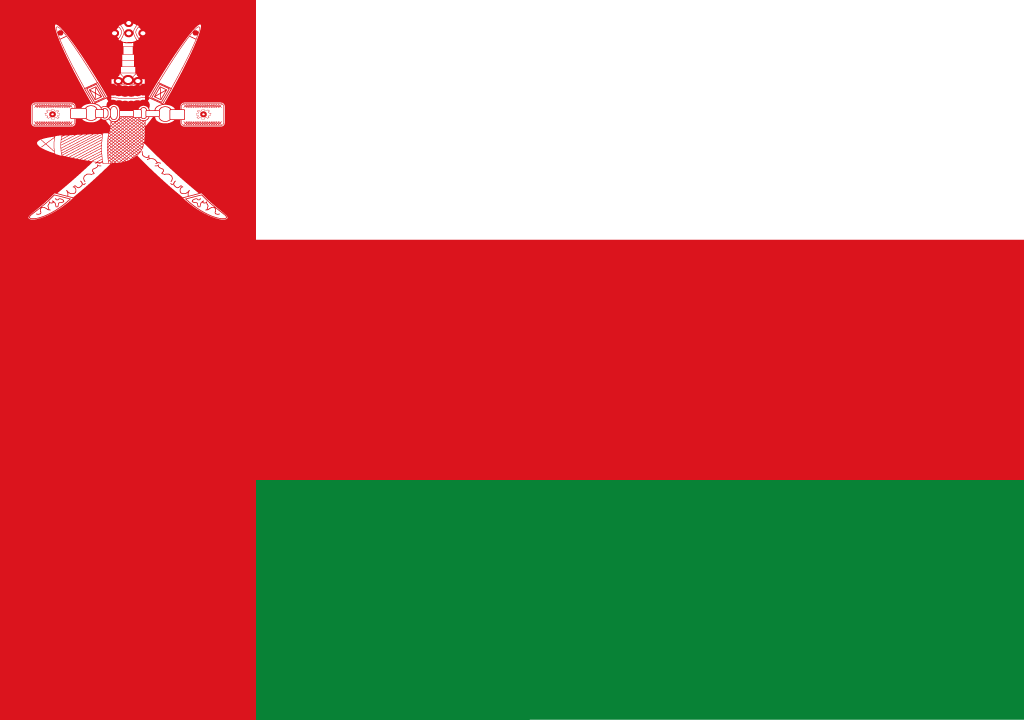
3 colors: white, red, green.
Meaning of the flag of Oman: Red is taken from Oman’s previous flag, representing the reigning Al Bu Said dynasty, also symbolizing the difficulties Oman overcame in its search for independence; white historically represents the imam, the Islamic religious leaders of the country and also represents peace and prosperity; green is the color of Islam and is also for the fertility of Oman as well as Al Jabal al Akhdar (the Green Mountains) in the north-east of the country. The national emblem is shown on the top left, a khanjar dagger in its sheath superimposed on two crossed swords in scabbards.
History of the Flag of Oman
The flag of Oman has three horizontal stripes: white at the top, red in the middle, and green at the bottom. On the left side, there’s a vertical stripe, slightly wider than the horizontal ones, also red. Together with the central red stripe, it resembles a red T laid horizontally.
The national emblem is on the top left corner, in white, and it dates back to the 18th century. It’s the symbol of the Albusaidi Dynasty, with two swords that cross over a khanjar, a typical Arabian curbed dagger.
The red is inherited from Oman’s traditional flags. The white symbolizes peace, and it’s traditionally associated with the Imam, Oman’s religious leader. The green symbolized the “Green Mountains,” a mountain range in the north.
Until 1970, Oman used a simple red flag, which was common in the countries of that region. That year, the Sultan decided to give the country’s flag a little more personality and made the changes that we see today.
Officially, the current flag was adopted on 25 April 1995, but that was actually the date when the small changes were implemented.
Flag of Pakistan
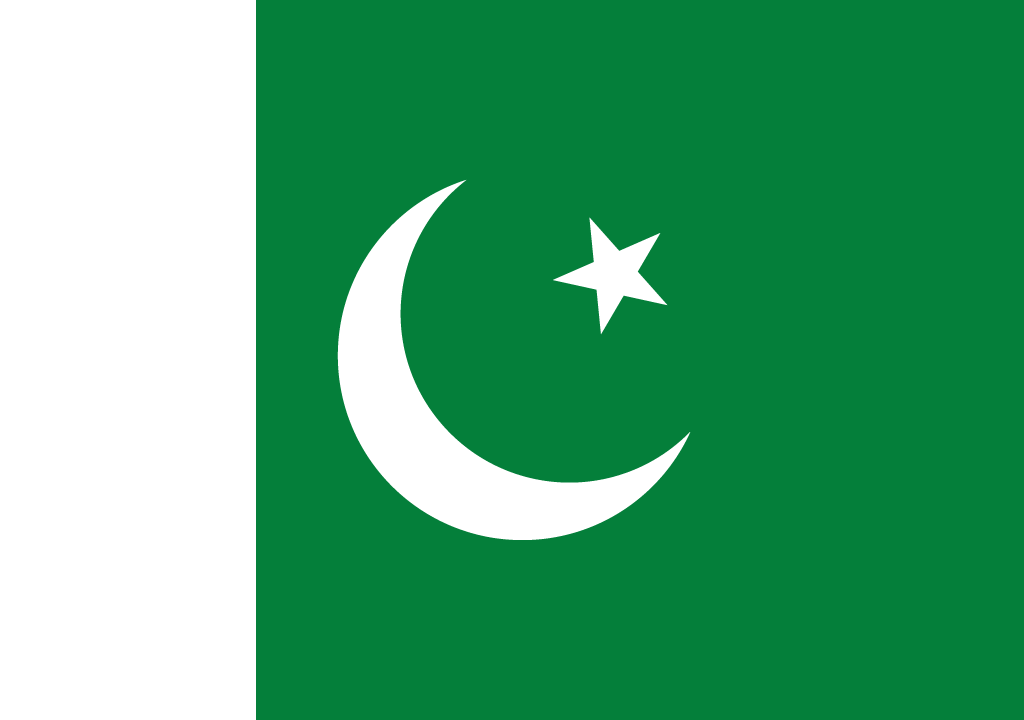
2 colors: white, green.
Meaning of the flag of Pakistan: The thin white stripe stands for the non-Muslim, religious minorities of Pakistan; the green larger part symbolizes the Islamic religion. The celestial symbols on the flag, the crescent and the star, represent progress, light and knowledge.
History of the Flag of Pakistan
The flag of Pakistan has two vertical sections: a narrower white on the left and a wider dark green on the right. There are a white Crescent Moon and five-point star overlapping the green area.
The white stripe symbolizes the minorities who live in Pakistan, specifically Hindus, Christians, and Buddhists, and the country’s religious tolerance. But white together with green is also associated with peace and prosperity. Green has a clear connection to Islam, Pakistan’s main religion, also symbolized by the Crescent Moon and the star. Those symbols also represent progress and enlightenment.
The flag was adopted during a meeting of the Constituent Assembly on 11 August 1947, just three days before Pakistan’s independence. It was designed by Syed Amir-uddin Kedwaii, a charismatic Pakistani political leader, who was inspired by the flag of the All-India Muslim League. The deeper roots of the flag go back further in time, to the Delhi Sultanate, the flag of the Ottoman Empire, and the Mughal Empire.
Flag of Palestine
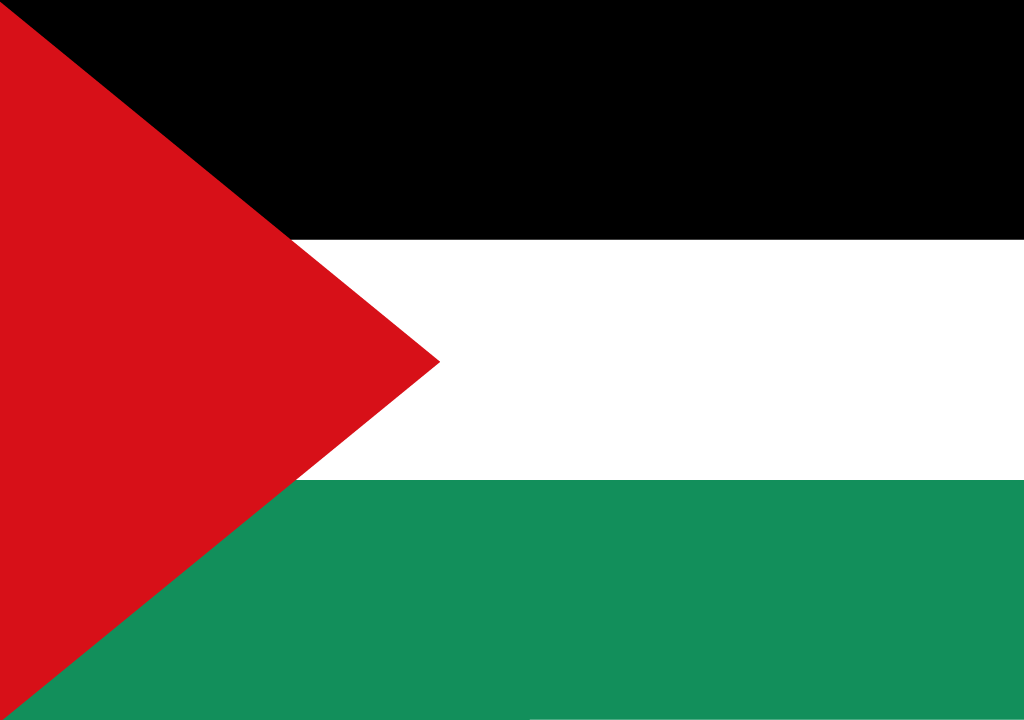
4 colors: black, white, green, red.
Meaning of the flag of Palestine: The colors in the flag of Palestine depict a certain time in the History of Islam. Red represents the Khawarij, the Islamic group who formed the first republican party in the early days of Islam and the Arab tribes who participated in the conquest of North Africa and Andalusia. In modern times, red stands for the Ashrafs of the Hijaz and the Hashemites, descendants of the Prophet. Black is for revenge and the color of the headdress worn when leading troops into battle in the period of the Prophet Mohammad (570-632). Also, during the Abbasid Dynasty (750-1258), black was used as a symbol of mourning for the assassination of relatives of the Prophet and in remembrance of the Battle of Karbala. White was the symbolic color of the Umayyads, who ruled for ninety years in Damascus (661-750). Back then, white was a reminder of the Prophet’s first battle at Badr and a way to distinguish themselves from the Abbasids using this color to mourn. Green is used after the Fatimid Dynasty (909-1171) in North Africa, symbolizing their allegiance to Ali, the Prophet’s cousin, who was once wrapped in a green coverlet in place of the Prophet to frustrate an assassination attempt.
History of the Flag of Palestine
COMING SOON
Flag of Philippines
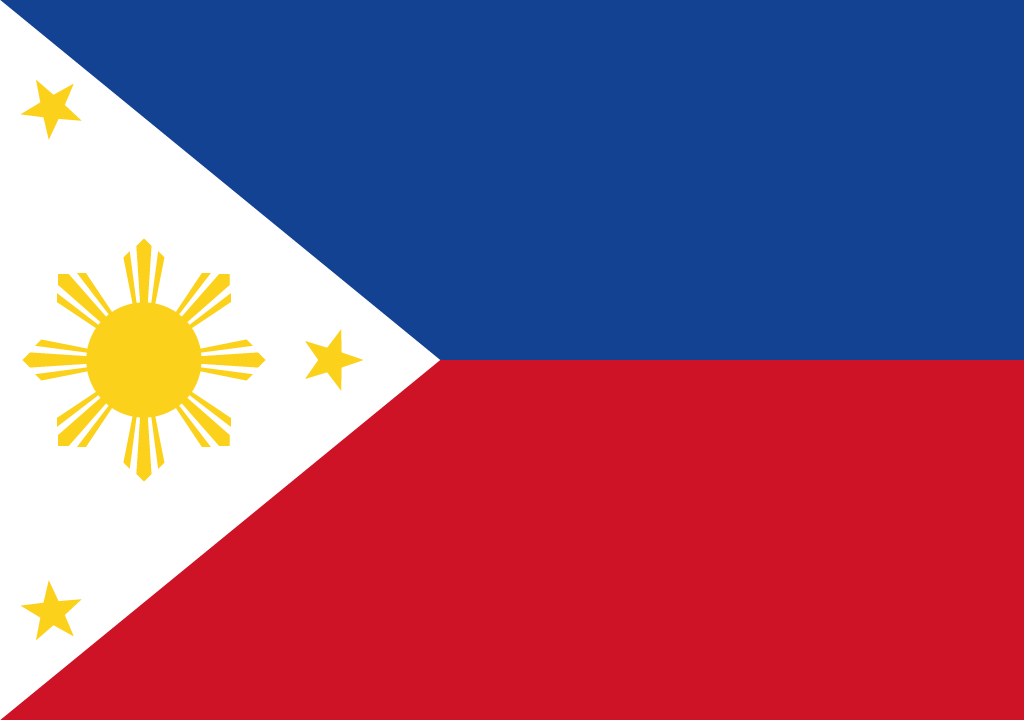
3 colors: blue, red, white.
Meaning of the flag of Philippines: Blue stands for the willingness to sacrifice oneself for freedom, peace, truth and justice; red signifies courage and patriotism; white stands for liberty, equality and fraternity. The three five-pointed stars represent the three major groups of islands where the revolution started: Luzon, Visayas, and Mindanao. The yellow sun represents unity, freedom, democracy and sovereignty. Each of its rays stand for one of the original provinces of the Philippines, at the time of the Revolution against Spain in 1896: Manila, Cavite, Bulacan, Pampanga, Nueva Ecija, Tarlac, Laguna and Batangas.
History of the Flag of Philippines
The flag of the Philippines strongly resembles the Czech Republic one. It has two horizontal stripes, top blue and bottom red, and a white triangle with the base on the left side of the flag and the vertex pointing towards the center. Over this triangle, there’s a sun in the middle and three small yellow five-point stars near each one of the three vertexes.
The flag was designed by Nationalist leader Emilio Aguinaldo, who fought the Spanish presence in the Philippines at the end of the 19th century.
The colors of the flag were chosen based on the colors of the American flag, a country with historical connections to the Philippines. The small stars represent the main islands of the archipelago: Mindanao, Luzon, and Visayas. The sun symbolizes the union of the Filipinos, freedom, the country’s sovereignty, and democracy. Its eight sunbeams shaped like a sword symbolize the eight provinces (Manila, Bulacan, Cavite, Pampanga, Bataan, Laguna, Batangas, and Nueva Ecija) that rebelled against the Spanish and that formed the Philippines in the beginning.
A peculiar fact about the Philippines flag: if the colors of the stripes are reversed, red at the top and blue at the bottom, it means the country is at war.
The flag was officially adopted by the First Philippine Republic on 12 February 1998.
Flag of Qatar

2 colors: purple, white.
Meaning of the flag of Qatar: Purple represents the loss of lives in the diverse battles and conflicts fought by Qatar, mainly in the last half of the 19th century; white symbolizes harmony. The nine-point saw-toothed stripe means that the country is the 9th member of the “resolved Emirates” of the Persian Gulf, following the end of the pact between Great Britain and Qatar in 1916.
History of the Flag of Qatar
The flag of Qatar has two different color areas: white on the left and maroon on the right. Both areas are divided by a zig-zag line, an unusual design detail you only find in the flags of Qatar and Bahrain.
The color symbolizes the intense heat from the sun but also the natural pigment of the same color traditionally used in Qatar.
As it happened with neighboring countries, Qatar’s former flag was all red. As with the flag of Bahrain, the white stripe on the left side was introduced at the end of the 19th century, following a naval agreement with the United Kingdom that required all countries involved to have a white stripe on the left side of their flags.
Shortly after, Sheikh Mohammed bin Thani dropped the red and adopted the color we can see in the current flag. This one was defined in the 1960s, with the changes ordered by Sheikh Ali Al Thani.
The current flag was officially adopted when the country became independent on 9 July 1971.
Flag of Russia
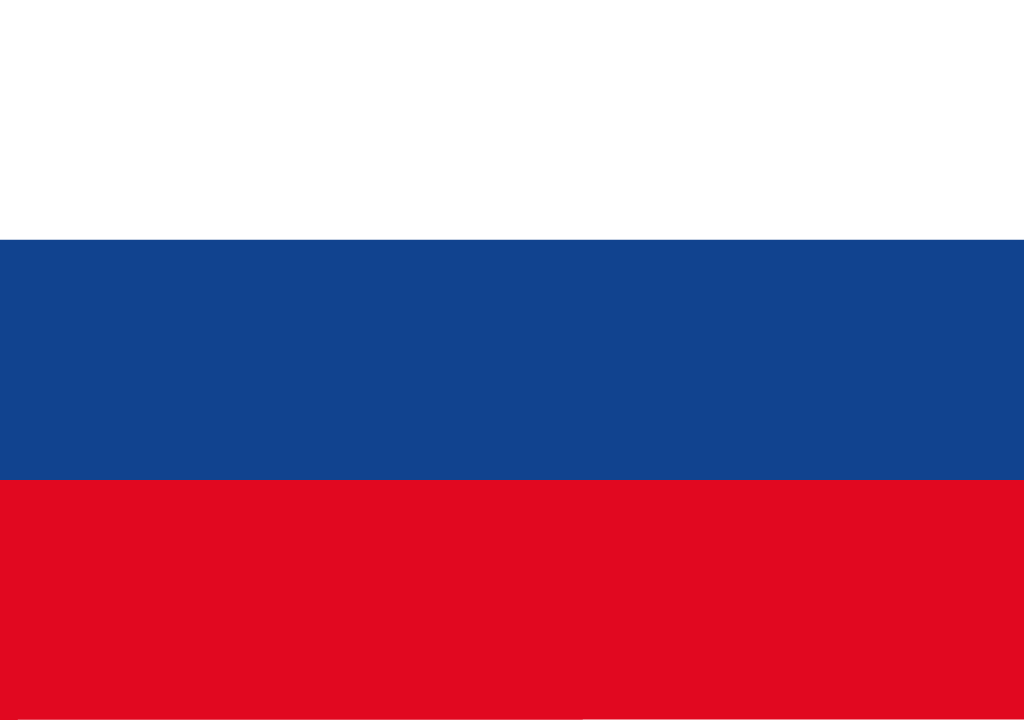
Flag of Russia
3 colors: white, blue, red.
Meaning of the flag of Russia: The Russian Federation flag contains the Pan-Slavic colors of red, blue and white. Since there is no official meaning appointed to the colors by the Russian government, several theories exist. One refers that the colors came from the Grand Duchy of Moscow and depict Saint George in a silver armor, on white horse, wearing a blue cap on a red field. Another theory explains that white represents God, blue is for Tsar and red for peasants. Even another theory attributes white to a bright future, blue for clouded present and red for the bloody past.
History of the Flag of Russia
The current flag of Russia has three horizontal stripes: one white on the top, one blue in the middle, and one red on the bottom. The color scheme is associated with the Pan-Slavic movement and can be seen across many Slavic countries including Croatia, Czech Republic, Slovenia, and Serbia.
Although this is the traditional flag of Russia, from 1917 to 1991, during the communist era, the Soviet Union had a red flag with the traditional communist symbol, the sickle and the hammer, in gold on the top left corner.
In 1991, after the collapse of the Soviet Union and the end of the communist regime, the traditional Russian flag was reinstated.
Russia had officially adopted the current flag in 1696, probably inspired by the flag of the Netherlands, one of the oldest flags in the world.
Some say the flag appeared for the first time because of the Dutch shipbuilder, Butler, in charge of building the first Russian warship, Oryol. When asked what kind of flag did he want for the first ship of his Navy, Tsar Alexander I left that decision up to the Dutchman and told him to do the same as he would do in his home country. Butler than created the Russian flag, that was very similar to the one of his own country.
Others claim that Peter I ordered a warship from the Netherlands in 1694 and when he saw the flag on the ship, adopted the same template but changed the color sequence.
There are, naturally, several interpretations of what the colors on the flag represent but the most popular one associates white with honesty and decency, blue with loyalty and chastity, and red with courage, generosity, and love.
Flag of Saudi Arabia
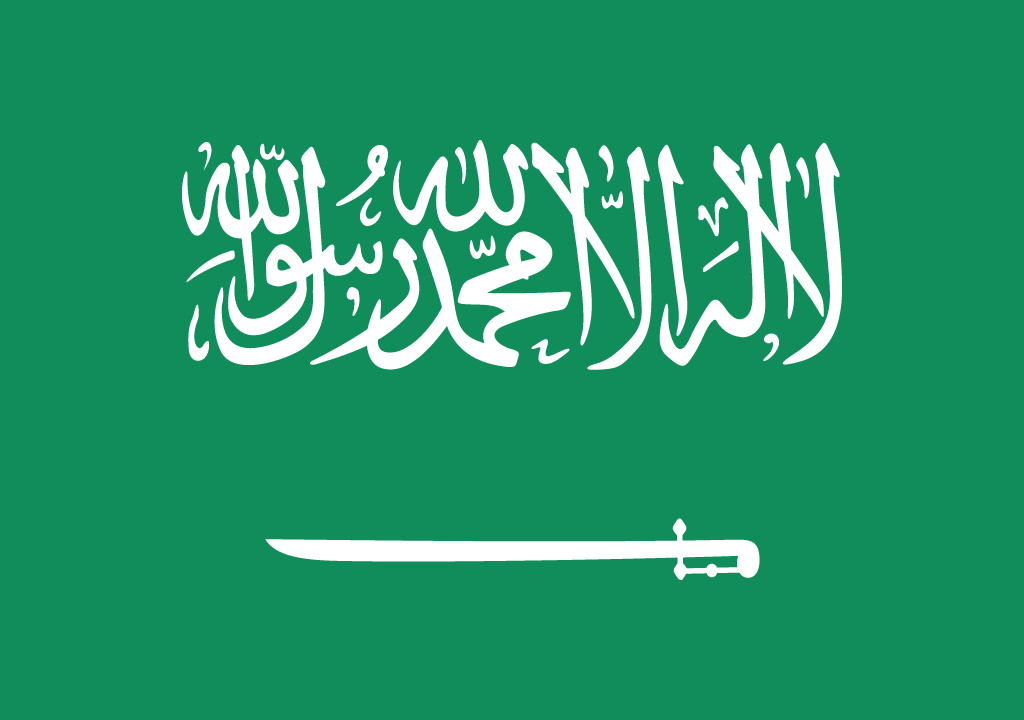
2 colors: green, white.
Meaning of the flag of Saudi Arabia: The background green color is the official color of Islam. The Arabic writing on the flag is the Islamic declaration of faith and it reads,”There is no God but Allah and Muhammad is his Prophet”. The text is known as Sahada and the script is in Thuluth. Under it there is a sword symbolizing the victories and justice of Abdul Aziz Ibn Saud.
History of the Flag of Saudi Arabia
The flag of Saudi Arabia is green, the color of Islam, which immediately reveals the importance of the national religion. In the Saudi Kingdom, the green has additional significance because it’s also the color of the Sunni and Wahhabism, an extremely important movement in the country.
In the center, on the top half of the flag, an inscription in Arabic that says “There is no god but Allah; Muhammad is the Messenger of God.”
Under the inscription, a sword pointing to the left, which symbolizes the unification of the country in the 12th century under the leadership of Ibn Saud, but that currently represents the strict application of the law.
The flag has two identical sides, to make sure the inscription is always read correctly and that the sword is always pointing to the left side.
The flag has a long history, but green had only been used as the main color before between 1744 and 1818 when the First Saudi State used a flag of the same color with a Crescent Moon in the center. Between 1824 and 1891, and later between 1902 and 1921, the Crescent Moon was replaced by the inscription. The sword was introduced in 1921 but initially pointed to the right. The current flag began to be used in 1932, and the current version was officially adopted on 15 March 1973.
Flag of Singapore
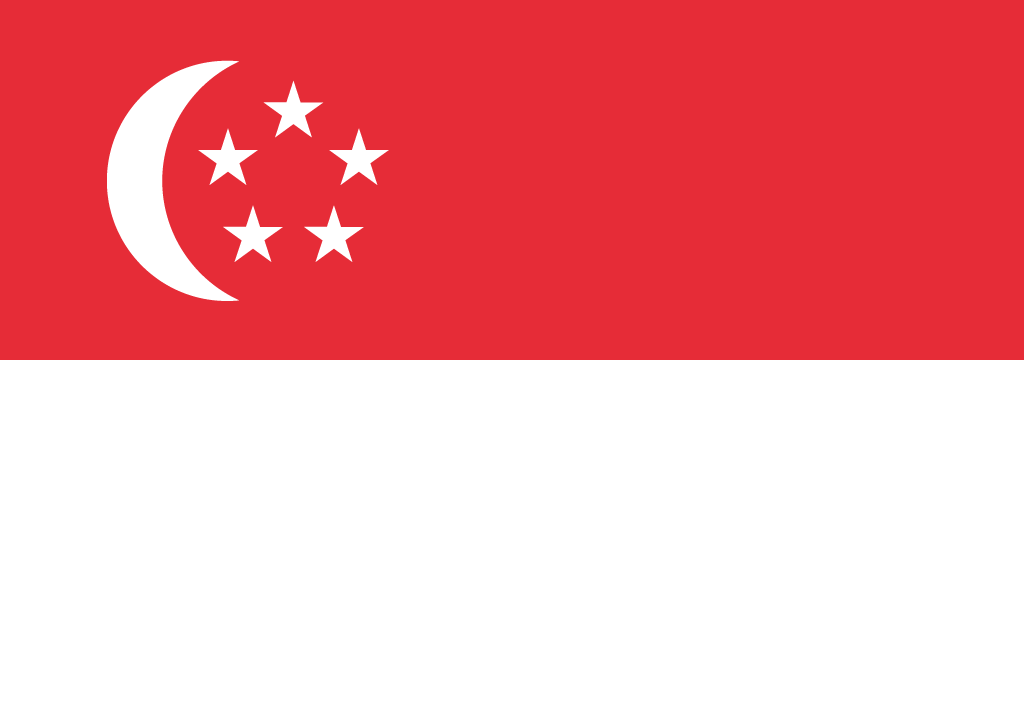
2 colors: red, white.
Meaning of the flag of Singapore: Red stands for brotherhood and equality; white is for purity and virtue. The crescent symbolizes the young nation starting to reach its peak. The stars are for the ideals of the new Singapore nation: democracy, peace, progress, justice and equality.
History of the Flag of Singapore
The flag of Singapore has two horizontal stripes: red at the top and white at the bottom. On the top left corner over the red stripe, there’s a symbol of a white Crescent Moon with a circle of five white five-point stars to the right.
The stars represent democracy, peace, progress, justice, and equality. The Crescent Moon symbolizes the importance of Islam in the country, honoring the Malay minority who lives in Singapore.
Officially, the flag symbolizes the rise of a new nation, the red symbolizes equality, and the white symbolizes chastity and purity.
The flag was adopted on 3 December 1959, when the United Kingdom granted autonomy status to Singapore. Before that, they used the same flag as the European country.
Flag of South Korea
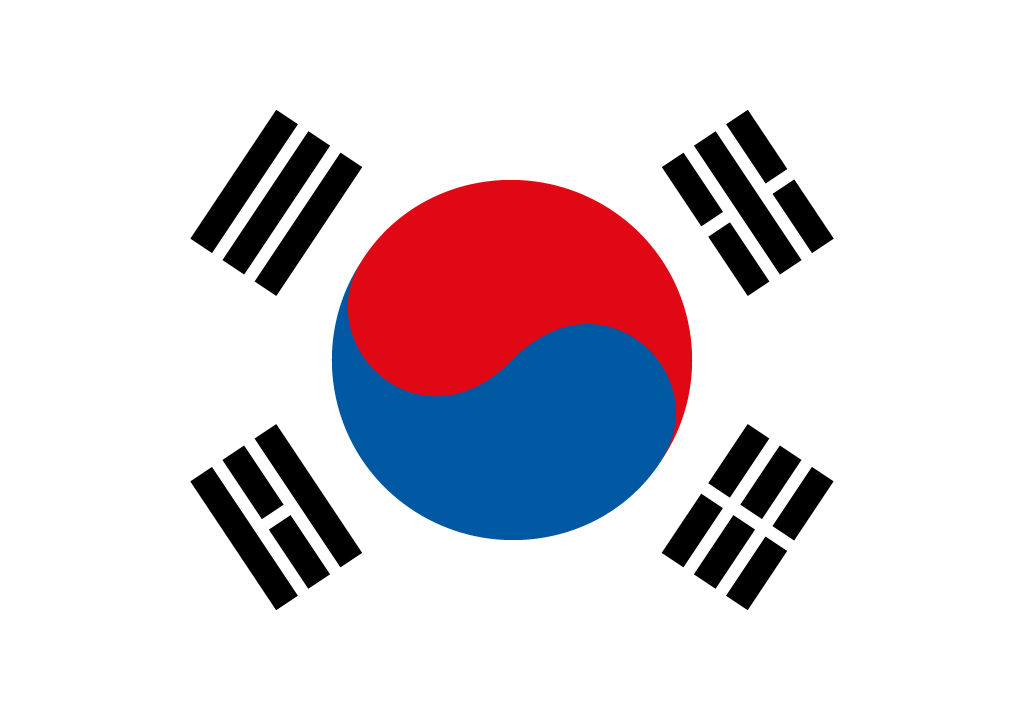
4 colors: white, red, blue, black.
Meaning of the flag of South Korea: The white background represents the purity of the people, peace and purity. The emblem is called the Taegeuk and symbolizes the source of all objects in the universe, standing for an uninterrupted progress in eternity. The blue section stands for the negative cosmic forces of the yin and the red one represents the opposite positive forces of the yang. The four trigrams represent the five fundamental elements: water, fire, wood, earth, and metal.
History of the Flag of South Korea
The flag of South Korea, called Taegukgi in Korean (which translates into “the supreme final flag”) is full of symbols, inspired by philosophical principles that have shaped the country’s culture and thinking for hundreds of years.
The background is white with a symbol in the center that represents the cosmic harmony and balance between opposing powers, what the Koreans call yin and yang. In the symbol, two areas gather to form a circle, red at the top and blue at the bottom. The red symbolizes the negative forces and blue represents the positive forces.
This circle is surrounded by four trigrams, called kwae, individually. These elements that in its whole represent movement and harmony are composed of three lines that can be a complete line or a line split in two. The kwae in Chinese Philosophy symbolize the four elements: sky, fire, earth, and water.
The flag’s white background symbolizes purity, hope, and peace.
The flag was initially adopted on 27 January 1883, during the Joseon Dynasty, whose rulers didn’t acknowledge the need for a national flag. On 15 October 1949, it became the official flag of South Korea, with some changes in details in 2011.
Flag of Sri Lanka
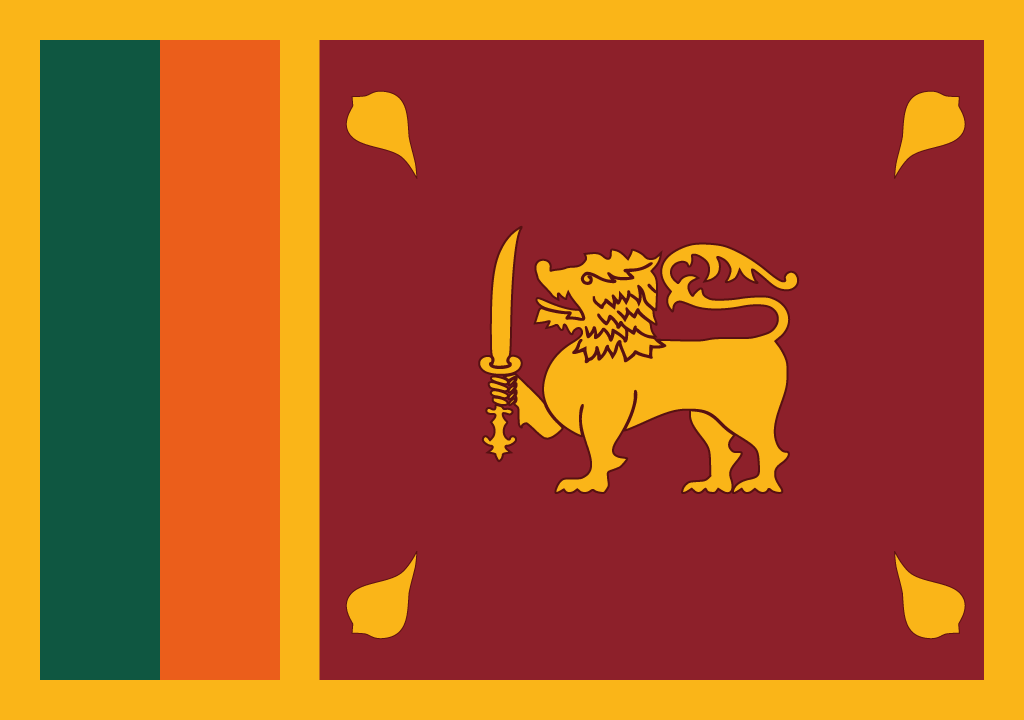
4 colors: yellow, green, orange, red.
Meaning of the flag of Sri Lanka: The dark red background is after the early Sri Lankan flags. The green and orange narrow vertical stripes represent the minorities in Sri Lanka: green for the Moors (and Islam), orange for the Tamils. The yellow lion represents the native Sinhalese people of the island (Sinha means lion and is the name of the ancient royal dynasty in the region). The lion is holding a kastane sword, a symbol of bravery. The Bo leaves in each corner of the rectangle represent the four essential Buddhist concepts: Mettha (kindness), Karuna (compassion), Muditha (joy) and Upekkha (equanimity).
History of the Flag of Sri Lanka
The flag of Sri Lanka (former Ceylon) has a dark yellow frame all around and two smaller ones inside the rectangle, forming two areas. On the left narrower side, there is a green and an orange vertical stripe. On the right side, there’s a national symbol, a yellow lion with a sword that points up towards the sky over a maroon background.
There’s a specific symbolism for each part of the lion. The mane symbolizes religious vigilance, wisdom, and meditation. The hairs on the tail symbolize The Noble Eightfold Path. The beard symbolizes purity of words, the sword symbolizes the four elements (earth, fire, air, and water), the nose symbolizes intelligence, and the two front paws symbolize purity in managing wealth.
This is a symbol that’s traditionally linked to justice and law, and it was adopted in its more generic form in 1948. It’s quite an old element in local flags and emblems, with references going back to the 5th century BC when Vijaya, the first King of Sri Lanka, reached the island carrying a banner with the symbol of a lion.
There are four small yellow leaves encircling the lion. Those are a recent addition to the flag, appearing for the first time in 1972 when the country officially changed its name from Ceylon to Sri Lanka. Each one of these leaves represents an important principle of Buddhism: kindness, compassion and desire to contribute to the good of society, joy, peace and mental balance.
The stripes on the left were included in the flag in 1815 and symbolize the main minorities living on the island: the Hindu Tamils and the Muslims, while the lion is associated with the Singhalese majority.
The flag of Sri Lanka has been used as a national flag since independence in 1948 and was revised when the country changed its name. The current version was officially adopted on 22 May 1972.
Flag of Syria
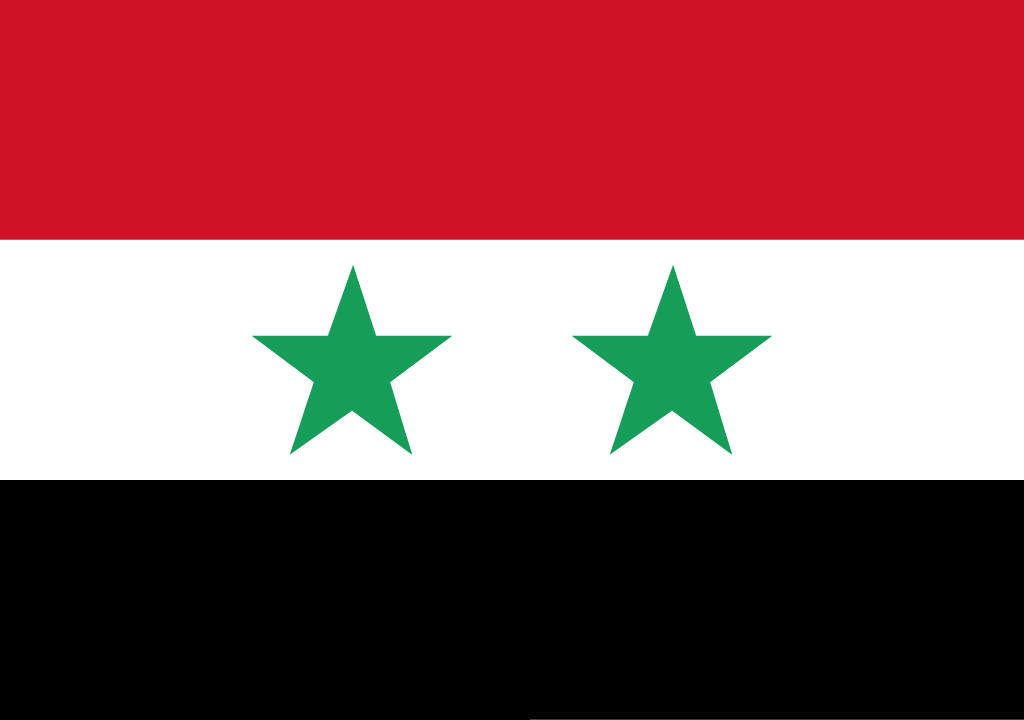
4 colors: red, white, black, green.
Meaning of the flag of Syria: The flag of Syria has the four pan-Arab colors, representing the various dynasties that ruled the region. Red represents the Islamic groups Khawarij and Hashemites; white stands for the Umayyad Dynasty; black is for the Prophet Mohammad and the Abbasid Caliphate; green symbolizes the Fatimid Caliphate. There are also other meanings attributed to some of the colors of the Syrian flag: red for the sacrifices made in the fight for freedom; white for peace; black for Syria’s colonial history.
History of the Flag of Syria
The flag of Syria has three horizontal stripes: black at the top, white in the middle, and red at the bottom. These are the colors of the Pan-Arab movement, inherited from the flags that were used during the Arab Revolution (1916) against the presence of Ottomans in Arab territories of the Middle East.
There are two green five-point stars in the middle, a representation of the country’s political association to Egypt (1958-1961).
Red symbolizes the Hashemite Dynasty, and the blood shed during the fight for freedom. White represents the Umayyad Dynasty and the bright and peaceful future ahead. Black represents the Abbasid Dynasty and the oppression of the Syrian people. Green is the color of the Fatimid Dynasty, and the stars represent Syria and Egypt.
The current flag was officially adopted on 30 March 1980.
Flag of Tajikistan
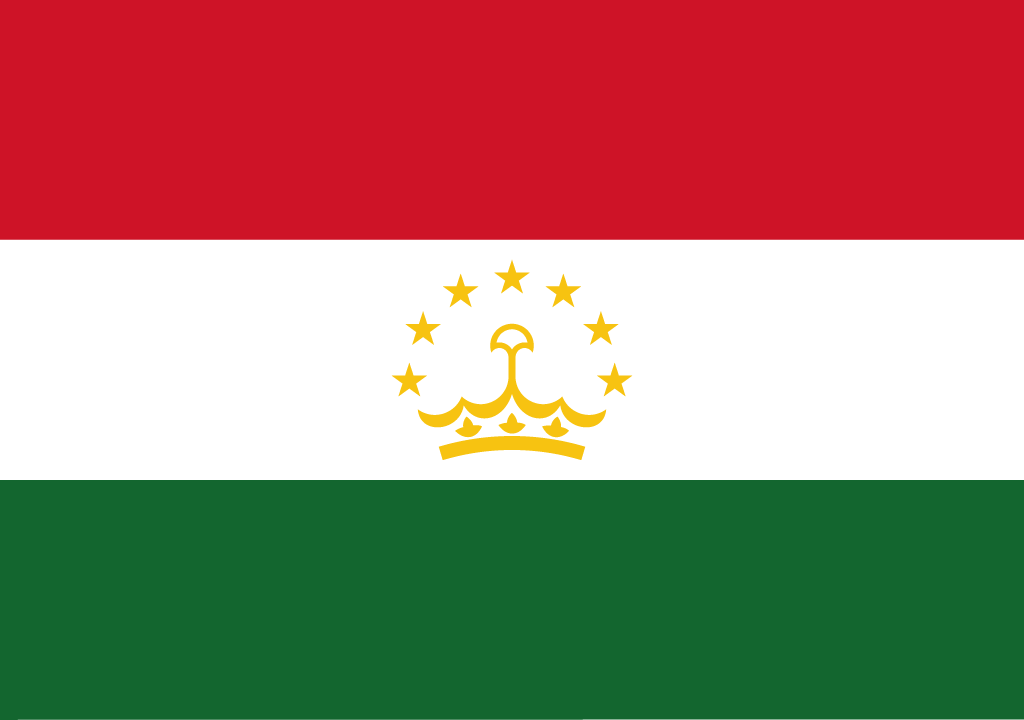
3 colors: red, white, green.
Meaning of the flag of Tajikistan: Red represents Tajikistan’s independence and the land; white stands for the country’s purity and the cotton industry; green symbolizes Tajikistan’s agriculture. The crown and stars stand for Tajik sovereignty, the union of workers and the unity of Tajikistan’s social classes.
History of the Flag of Tajikistan
The flag of Tajikistan has three horizontal stripes: red at the top, a wide white stripe in the middle, and green at the bottom. In the center, on the white stripe, there is a golden crown with seven five-point stars laid in a semicircle.
These stars symbolize the friendship of Tajikistan with all other countries and the crown represents the sovereignty of the country and its people. The word tâj, from which the name of the country originates, means “crown” in Farsi.
The number of stars, seven, has a strong tradition in Tajikistan, being associated with an idea of perfection and happiness, associated with the myth that the Paradise has seven mountains and seven orchards, with a star shining on each mountain.
The red stripe is associated with national unity, victory, and sunrise and is also a reference to the country’s Soviet past, the workers and the blood shed when defending the Nation. White symbolizes purity and morals as well as snow in the mountains and the cotton that grows in Tajikistan. Green celebrates the fertility of the earth, Islam, and the celebration of Novruz, the New Year on the Persian calendar.
Another interpretation says that the flag symbolizes the union of the people, with the red symbolizing the workers, the white symbolizing the intellectuals and the green symbolizing the peasants.
The current flag was adopted on 24 November 1992 following the independence of Tajikistan after the collapse of the Soviet Union.
Flag of Thailand
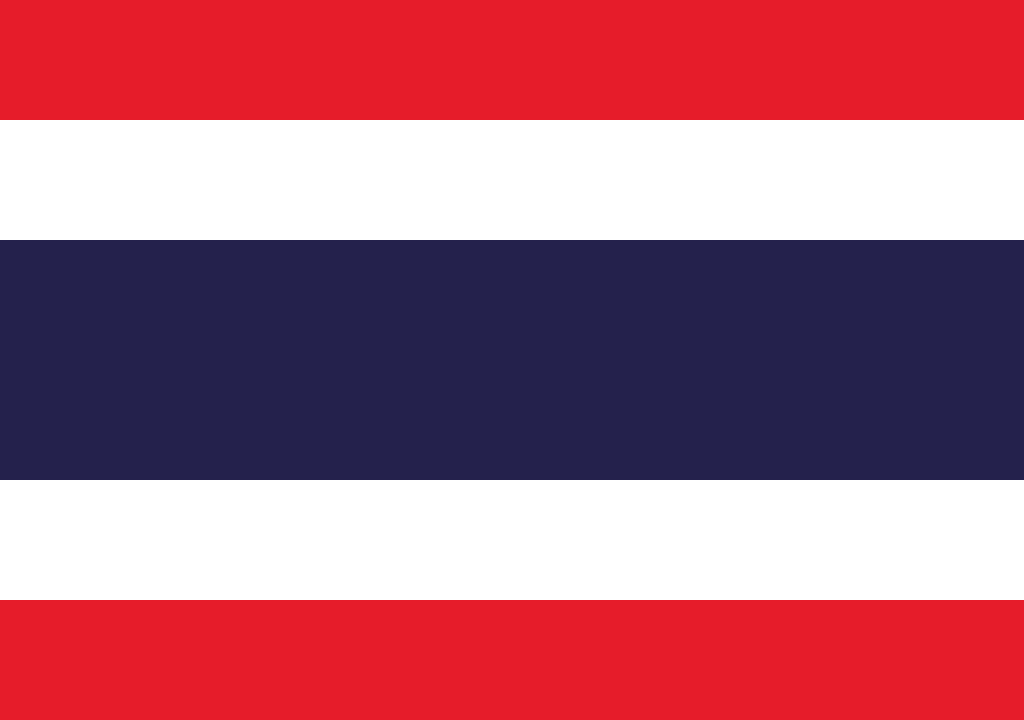
3 colors: red, blue, white.
Meaning of the flag of Thailand: Blue is the national color of Thailand, representing the Thai monarchy; white is for purity and is the color of Buddhism, the main religion of Thailand.
History of the Flag of Thailand
The flag, known in the country as triranga, which means tricolor, has five horizontal stripes, with one, wider, in the center, in blue, and the others arranged like a mirror: white and then red at the top and the bottom.
There is no official interpretation of the flag or its color. One possible explanation relates the colors of the flag to the core values of Thailand, the trilogy Nation-King-Religion. In this case, the red would symbolize the land and the people, the white the religions in Thailand and the blue the monarchy.
Until 1917 the flag had the symbol of an elephant, then replaced by the wider blue stripe, in the center. The current design dates from that time, representing Thailand’s solidarity with the allies who fought in the First World War, especially France. In fact, blue, white and red are the basic colors of the flags of the leading countries involved in the fight against Germany and its allies, specifically France itself, Russia, the United Kingdom and the United States of America.
Not even the change of country name, from Zion to Thailand, changed the flag. We can, therefore, say that the current national flag was officially adopted on 28 September 1917.
Flag of Turkey
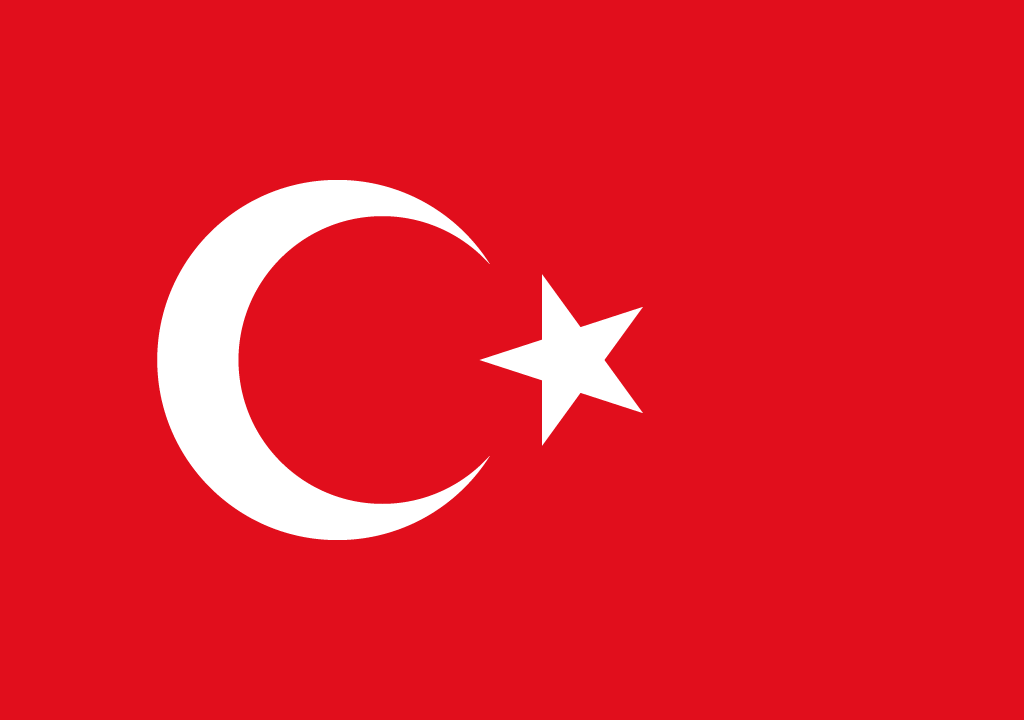
2 colors: red, white.
Meaning of the flag of Turkey: As mentioned in the Holy Koran, the star in the flag of Turkey symbolizes the Morning Star. Both the white crescent and the star are symbols of Islam.
History of the Flag of Turkey
COMIUNG SOON
Flag of Turkmenistan
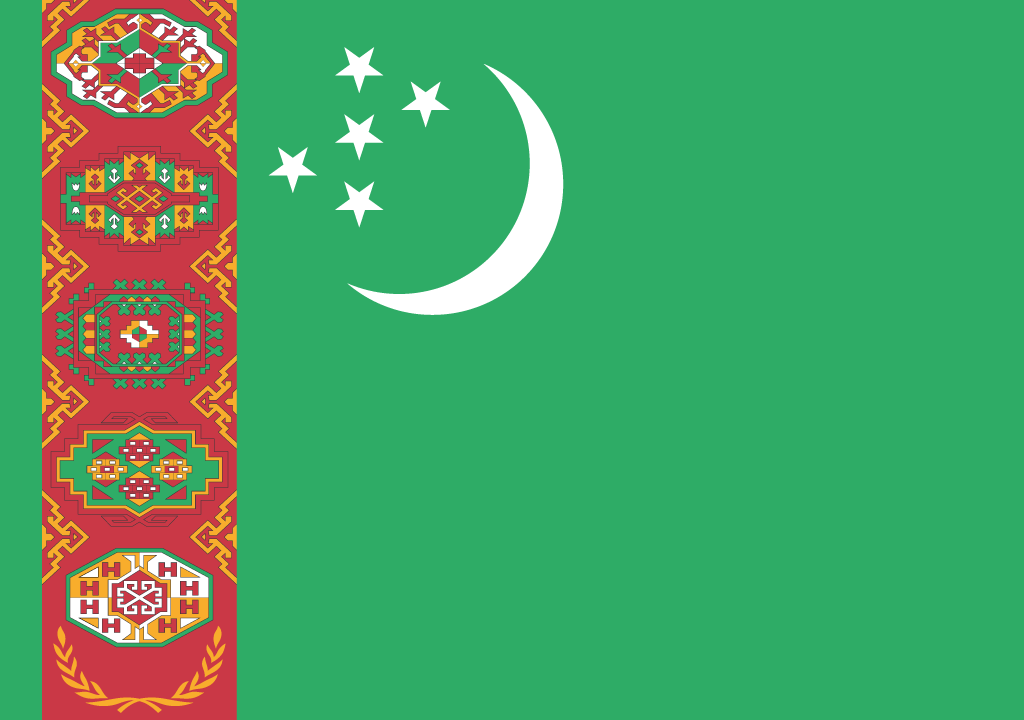
3 colors: green, red, white.
Meaning of the flag of Turkmenistan: The green background stands for Islam, as well as the white crescent and the five stars. The five white five-pointed stars represent the five regions of Turkmenistan. The vertical red stripe with five popular carpet designs symbolizes the famous carpet industry of the nation.
History of the Flag of Turkmenistan
The background of the Turkmenistan flag is green. On its left side, slightly away from the side, there is a decorative stripe based on a traditional pattern of the region, with five gulus, mostly used in the manufacture of carpets, a characteristic product of Turkmenistan.
This number was not chosen by chance, the five Gulus represent the five main tribes of the country: Tekke, Yomud, Saryq, Choudur, and Ersary. The middle one also represents the Salyr tribe, whose importance has declined substantially.
At the base of this pattern there is an olive branch, which symbolizes peace among nations.
To the right of this decorative strip, there is a Crescent Room and five five-pointed stars arranged in a tilted X, both white. The stars symbolize the five regions of Turkmenistan: Ahal, Balkan, Dashoguz, Lebap, and Mary. The Crescent Room is a common element in the flags of Islamic countries, and in the case of Turkmenistan, this symbolism is reinforced by the dominant green, which is the color of Islam.
The flag was originally adopted on 19 February 1992, shortly after the independence of the country following the collapse of the Soviet Union. On 24 January 2001, it assumed the present design, although some official changes were made in some of the details.
Flag of United Arab Emirates
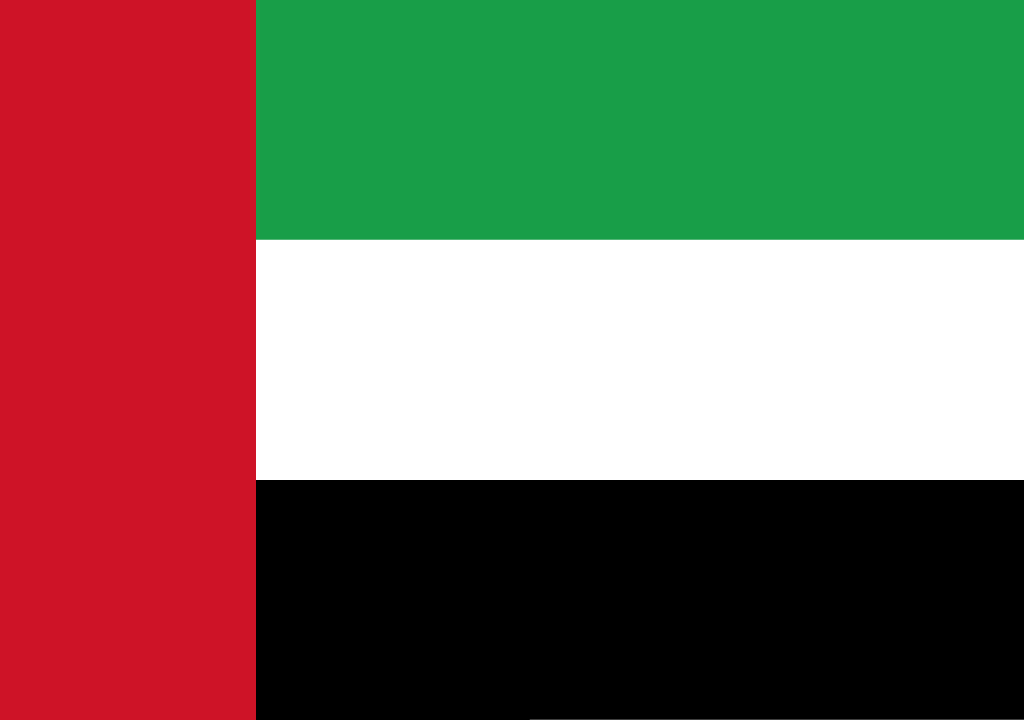
4 colors: green, white, black, red.
Meaning of the flag of United Arab Emirates: The colors in the UAE flag are pan-Arab ones and are also found on the flags of other Arab nations. Black stands for Islam’s early history with many wars in the Middle East during the first caliphates until around 1258 AD and also represents the oil of UAE; green is after the Fatimids Caliphate in the region and also symbolizes fertility and the greenery of the country; red is for the Ottomans and also for the blood and valor of wars; white is for peace and purity.
History of the Flag of United Arab Emirates
The flag of the United Arab Emirates flag has four colored stripes: one vertical on the left and three horizontals on the right.
The red stripe on the left covers about a fifth of the space and on its right are the three horizontal stripes, green, white and black from top to bottom.
These are the colors of the Arab Revolution, which took place between 1916 and 1918, to liberate the Arab territories of the Middle East then occupied by the Ottoman Empire, and which have since been used in most of the Arab country flags.
The country is a federation, established in 1971 by a set of six emirates to which others joined later. The Emirates maintain their own flags, and the flag of the United Arab Emirates was officially adopted on 2 December 1971, when the union was established.
Flag of Uzbekistan
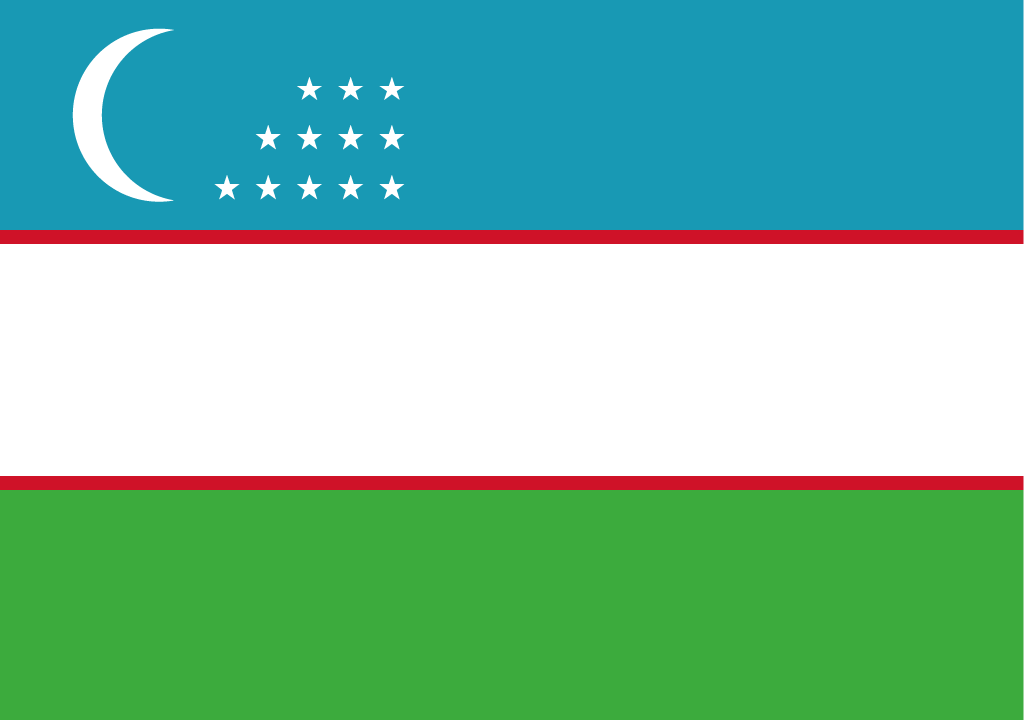
4 colors: blue, white, green, red.
Meaning of the flag of Uzbekistan: Blue represents water and the firmament; white is for peace; green symbolizes the abundant green vegetation on the fertile lands. The red stripes are the vital force of all living organisms that links good and pure ideas with the eternal sky and with deeds on earth. The moon represents Islam and the new birth of the nation. The 12 stars of the flag of Uzbekistan are for the twelve months of a year.
History of the Flag of Uzbekistan
This flag has three horizontal stripes separated by thin red lines. The top stripe is blue, of a very distinguishing shade that is traditional in this region. The middle one is white while the bottom one is green.
In the top left corner, on the blue stripe, there is a Crescent Room, and to its right a group of small five-pointed stars arranged in three lines: the bottom one has five stars, the middle one has four stars, and the top one has three stars.
Blue is a reference to Timur, the epic hero of Uzbekistan, who unified the tribes and created the first sense of a nation in the mid 14th century, and who used this color in his flag. It’s also related to the sky and water. White symbolizes peace and green represents the lands of Uzbekistan, fertility, and nature, but also Islam. The elements in red signify practicality. The Crescent Moon is another reference to Islam, the leading religion in the country, and the 12 stars correspond to the months of the Islamic calendar and the constellations of the zodiac.
Uzbekistan was the first country that rose from the end of the Soviet Union to adopt its own flag, which took place on 18 November 1991. The selection of the flag was the result of a public competition, which involved more than 200 proposals.
Flag of Vietnam
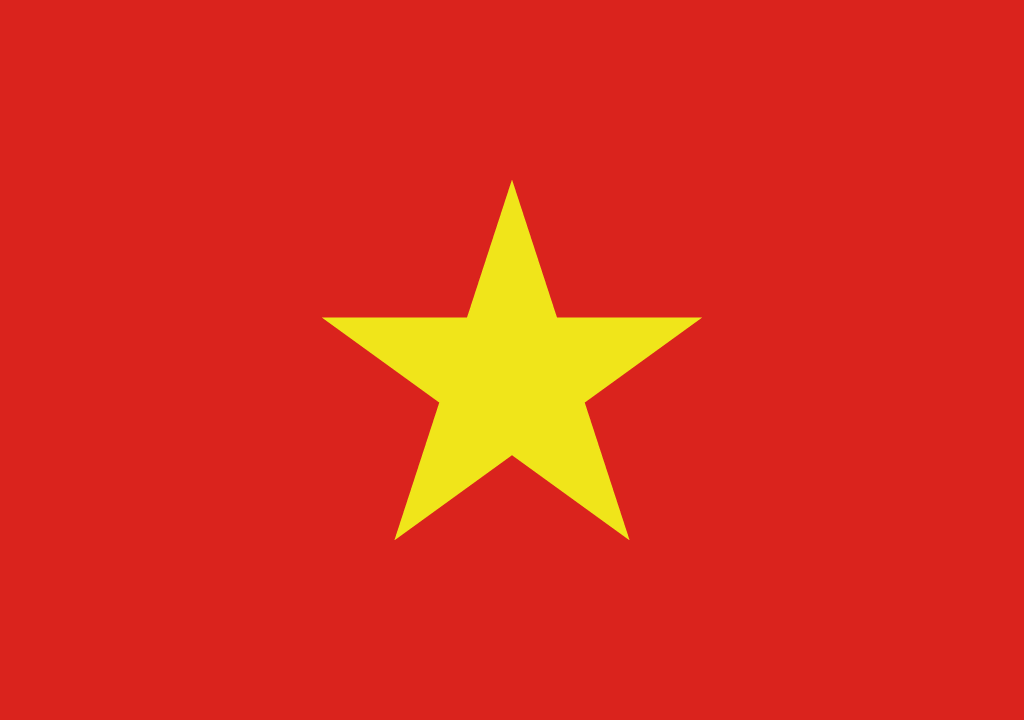
2 colors: red, yellow.
Meaning of the flag of Vietnam: There are more than one interpretations of the design of the flag of Vietnam. In the past, red was representative of the independence struggle of Vietnam; yellow symbolized the color of Vietnamese people; the five-pointed stars was for 5 traditional divisions of the people including scholars, peasants, craftmen, merchants and soldiers. After the establishment of Communism in Vietnam red was considered to represent the revolution of the working class; the yellow star was recognized to depict the leadership of the Communist Party of Vietnam.
History of the Flag of Vietnam
The flag of Vietnam is totally red, with a yellow five-pointed star of considerable proportions in the center.
The history of this flag goes back to 1940 when it was created, under strong communist influence, and used during the uprising against the French occupation that took place that year. From 1941 it was used by the Viet Minh, a movement of resistance against the Japanese occupants. With the end of Second World War and the separation of Vietnam into two parts, the southern one under Western and especially US influence, and the communist north, influenced by the Soviet Union, the already well-known flag was adopted by North Vietnam.
The symbolism of the flag is communist. Red represents the purposes of the Revolution and the five points of the star symbolize the classes of the Vietnamese society: intellectuals, farmers, workers, military and business people.
In 1976, with the end of the Vietnam War and its reunification under the protection of the North, the flag included the entire nation.
Flag of Yemen
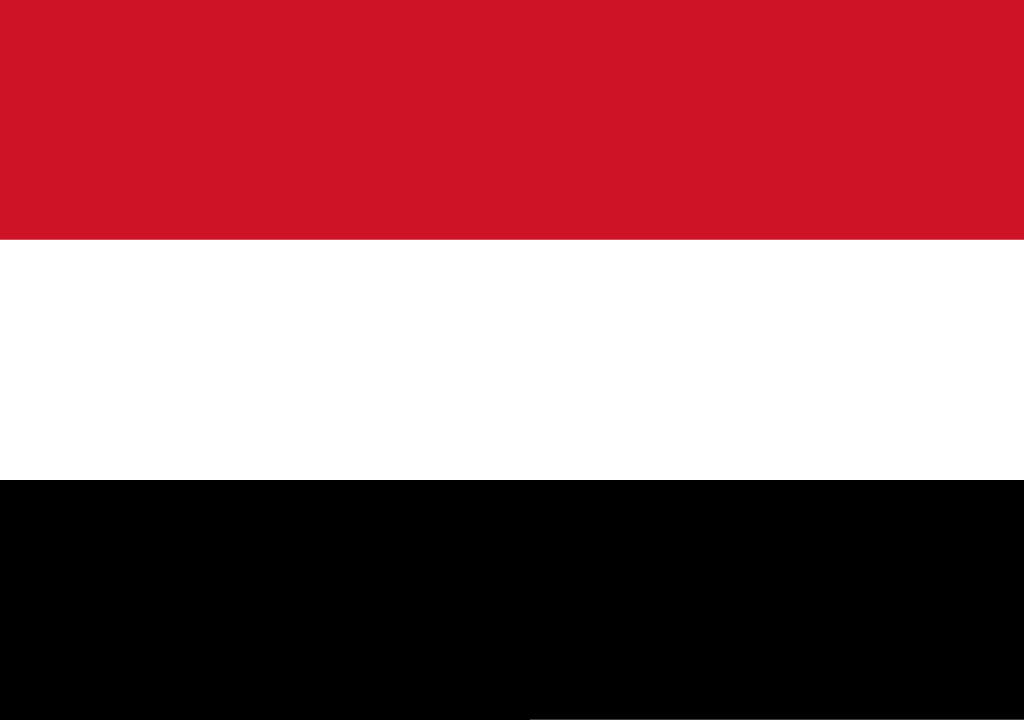
3 colors: red, white, black.
Meaning of the flag of Yemen: Since the population of Yemen essentially belongs to the Arab race, the three colors of the national flag of Yemen has the pan-Arab colors. Red stands for the blood spilt during the fight for freedom; white represents hope; black is for the dark past of Yemen.
History of the Flag of Yemen
The flag of Yemen is typically Arabic, using the Pan-Arabian color combination, which comes from the flags used by the revolutionaries during the Arab Revolution (1916-1918) to oust the Ottomans from the Arab lands of the Middle East.
It is, therefore, a three-colored flag, with three horizontal stripes. From top to bottom we have red, white and black. It is basically the so-called Flag of Arab Liberation, introduced by Egypt after the 1952 revolution.
According to the official interpretation, red symbolizes the blood shed by martyrs, white the hope for a better future and black is a reference to the darkest days of the past.
The current flag was adopted on 22 May following the unification of Yemen. Before that date, North Yemen and South Yemen had different flags, since they were two different countries.
Countries unrecognized, partially recognized or disputed
Flag of Abkhazia
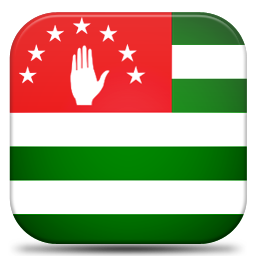
3 colors: green, white, red.
Meaning of the flag of Abkhazia: The canton is the symbol of Abkhazian statehood. The Abkhazian Kingdom first emerged in about 700-900 AD but the hand symbol appears on Genoese portolanos from the 13th-14th centuries. Moreover, in the Middle Ages, a dark red flag with a hand flew over Sabastopol at the site of the current capital of Abkhazia, Sukumi. The stars symbolize the seven main regions of historical Abkhazia: Sadzen (Dzhigetia), Bzyp, Gomaa, Abzhwa, Samurzaq’an, Dal-Ts’abal, and Pshoy-Aybga. Abkhazians (like many other peoples) also consider number seven as sacred and is widely attested in their religion, mythology and traditional culture. The stars all have five points because it is viewed as an ancient astrological symbol. The green and white stripes (seven in total) indicate religious tolerance and peaceful coexistence of Islam and Christianity. This pattern is also connected to the historical flag of the North Caucasus Republic, which consisted of seven republics.
Flag of Nagorno Karabakh

4 colors: red, blue, orange, white.
Meaning of the flag of Nagorno Karabakh: Based on the flag of Armenia, the flag of Nagorno Karabakh reflects the ties between them. The pointing arrow represents Artsakh’s current separation from Armenia and its hopes for union with the motherland. The design is also similar to the one in the world famous Armenia rugs.
Flag of South Ossetia
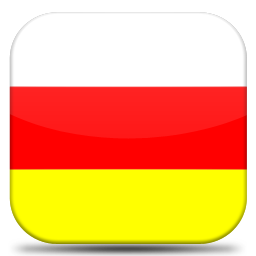
3 colors: white, red, yellow.
Meaning of the flag of South Ossetia: White represents moral purity; red stands for martial courage; yellow is for wealth and prosperity. The flags of North Ossetia-Alania and South Ossetia are almost identical. The only difference is their aspect ratio. The division of colors on the flags is said to symbolize the social structure of ancient Ossetian society, divided into three social groups forming an organic whole: military aristocracy, clergy and ordinary people.
Flag of Taiwan
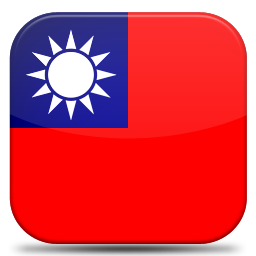
3 colors: red, blue, white.
Meaning of the flag of Taiwan: The three colors in the flag of Taiwan stand for the Three Principles of the People given by Sun Yat-sen, the first president of the Republic of China. Blue represents Nationalism and Liberty; white is for Democracy and Equality; red signifies the people’s Livelihood and Fraternity, as well as the earth and the blood of the martyrs who sacrificed their lives for the Republic. The twelve rays in the white sun symbolize the twelve months of the year and also the traditional twelve divisions of the day into two-hour intervals, known as shichen.
Flag of Turkish Republic of Northern Cyprus
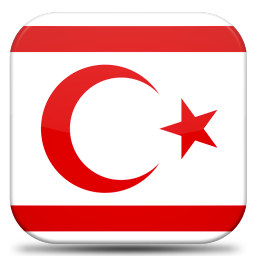
2 colors: white, red.
Meaning of the flag of Turkish Republic of Northern Cyprus: The flag of the Turkish Republic of Northern Cyprus is very similar to the flag of Turkey, with their elements and colors representing Islam. White was replaced by the red; red by the white. Two red strips were added but the crescent and star have remained unchanged.
Special entities recognized by international treaty or agreement
Flag of Hong Kong

2 colors: red, white.
Meaning of the flag of Hong Kong: Hong Kong is a Special Administrative Region of the People’s Republic of China. In the flag of Hong Kong, red stands for zest, celebration, and a festive mood. The flower is symbolizing harmony and the dichotomy between China and Hong Kong. Each of the petals has a five-pointed red star representing communism and socialism.
Flag of Macau

3 colors: green, white, yellow.
Meaning of the flag of Macau: The background green of the national flag of Macau is probably mare calusumps. The five golden stars are used after the flag of the People’s Republic of China. Their position over the lotus flower means that Macau is China’s water lily. The Lotus is the Asian symbol for purity, justice, and love.


